Monroe County Timeline
Most Significant Events
| Land Ordinance of 1785 1785, May 20 |
The Ordinance of 1785 established the process of land procurement by settlers in the new western lands. The land was surveyed and laid out in township and sections for purchase by settlers. The Ordinance helped raise money for the new United States since direct taxation was not legal at the time under the new Articles of Confederation. The system is still in use today.
Source: James H. Madison, Hoosiers: A New History of Indiana (Bloomington: Indiana University Press, 2014), 30-31.
|
| Northwest Ordinance passed by Congress 1787, Jul 13 |
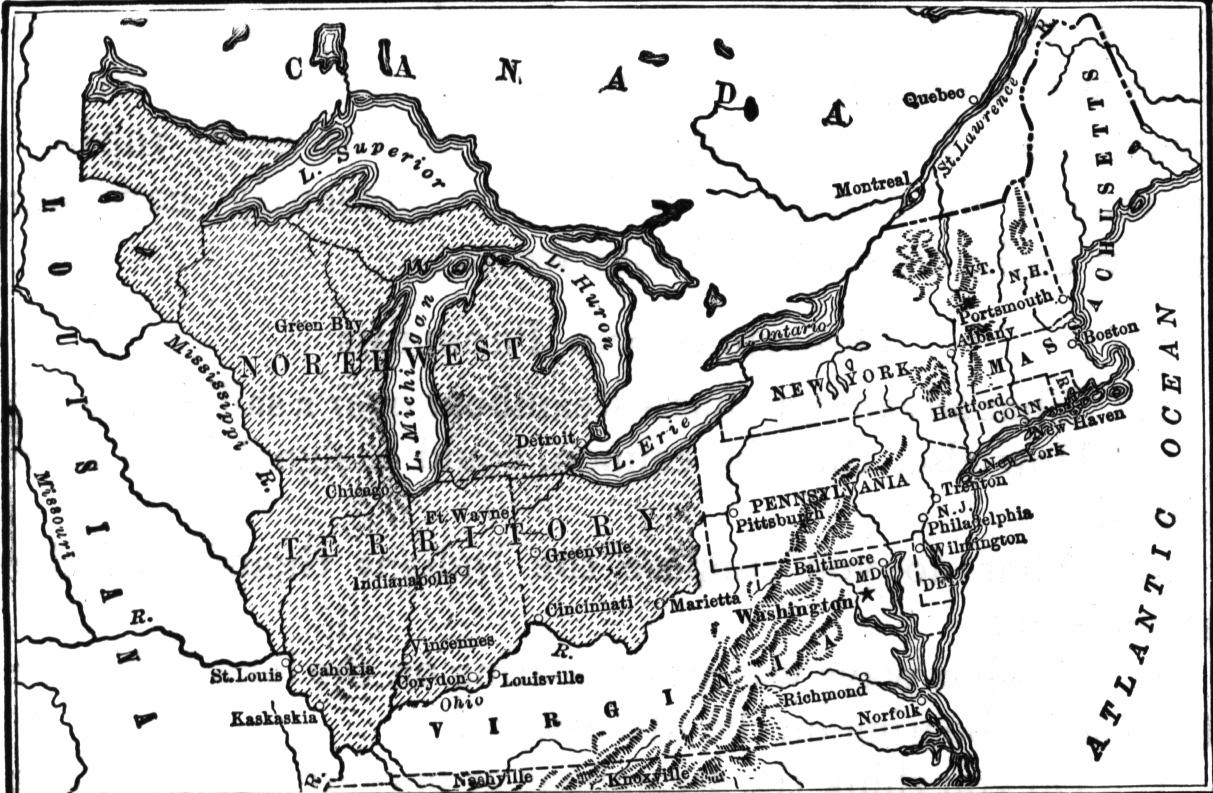 On July 13, 1787, Congress passed an ordinance—now called
the Northwest Ordinance—to govern approximately 265,000
square miles of the western land.The land was located north of the Ohio River, east of the MississippiRiver, and south of the Canadian border. It included present day Indiana. It nullified the Ordinance of 1784, which was never implemented, but included some of its ideas. On July 13, 1787, Congress passed an ordinance—now called
the Northwest Ordinance—to govern approximately 265,000
square miles of the western land.The land was located north of the Ohio River, east of the MississippiRiver, and south of the Canadian border. It included present day Indiana. It nullified the Ordinance of 1784, which was never implemented, but included some of its ideas.
Source: Indiana Historical Bureau, "Governing the New Land," Indiana Historian, March 1, 1999, 5.
|
| Indiana Territory created 1800, Jul 4 |
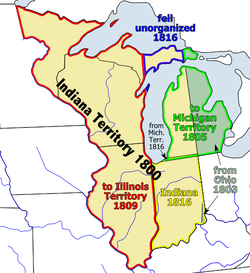 Indiana is designated a territory out of the what will become Indiana, Illinois, Wisconsin, parts of Minnesota and Michigan. Vincennes is made the seat of government at the organization of the territory. Indiana is designated a territory out of the what will become Indiana, Illinois, Wisconsin, parts of Minnesota and Michigan. Vincennes is made the seat of government at the organization of the territory.
Source: George Pence and Nellie C. Armstrong, Indiana Historical Collections Vol XIX: Indiana Boundaries (Indianapolis: Wm. B. Burford Printing Co., 1967), 138.
|
| Treaty of Ft. Wayne enacted 1809, Sep 30 |
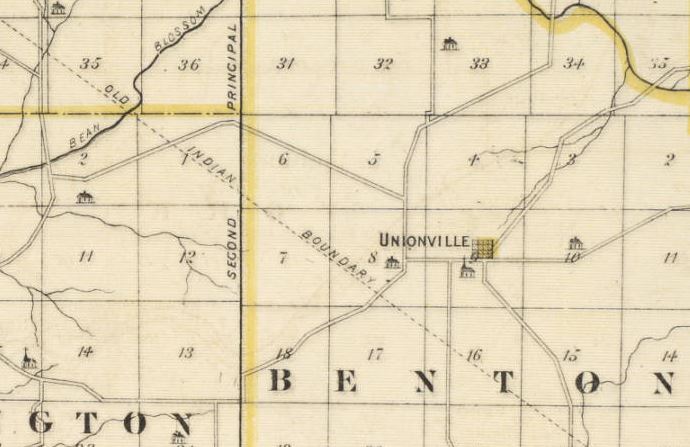 Governor William Henry Harrison signs land cession treaties with Indians or Native Americans, among other areas parts of the future Monroe County. The famous 10 o'clock line or "Old Indian Boundary" is the northern and eastern boundary. Governor William Henry Harrison signs land cession treaties with Indians or Native Americans, among other areas parts of the future Monroe County. The famous 10 o'clock line or "Old Indian Boundary" is the northern and eastern boundary.
Source: Russ F. Lockridge, Sr., The Story of Indiana (Oklahoma City, OK: Harlow Publishing Corp, 1951), 152-153. more...
|
| Croghan's Kentucky Rangers get orders 1811, Aug 28 |
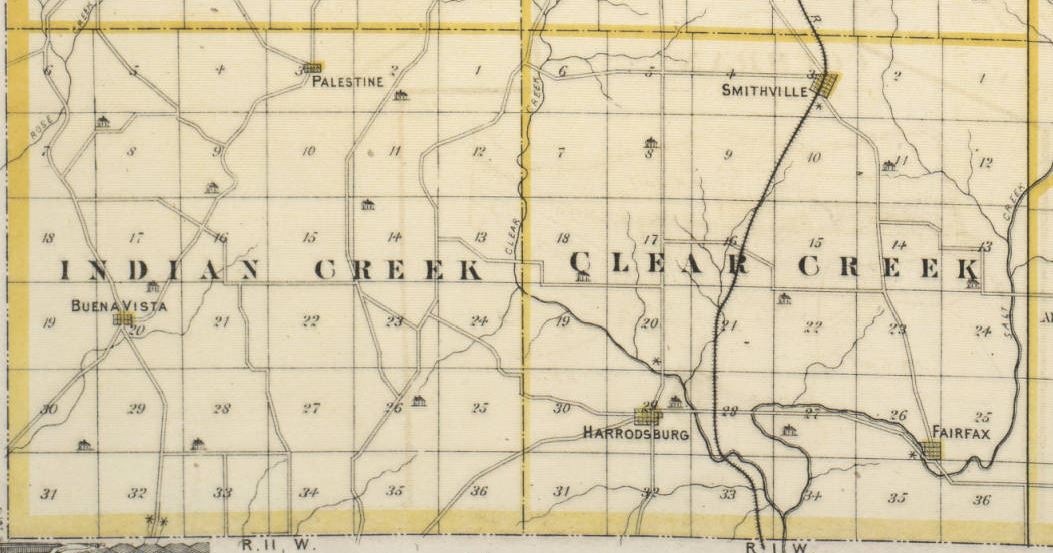 Major Croghan, leading the Kentucky Rangers, orders non-commissioned officers and enlisted men to trek into Indiana Territory with guides David McHolland and John Ros Neagy (Native American). Men called for duty: Sergeant Thomas Frisbee and Corporal P. Lowther. Privates are T. Grimes, E. Ephriam Noel, C. Mallott, T. Buskirk, Asa Thornton, B. Woodward, and R. Taylor. After reaching Clear Creek, a battle takes place with Native Americans or Indians and 22 white men are killed. [Image of 1876 map Clear Creek Township, sec. 18, where Cedar Bluff Nature Preserve is in 2018.] Major Croghan, leading the Kentucky Rangers, orders non-commissioned officers and enlisted men to trek into Indiana Territory with guides David McHolland and John Ros Neagy (Native American). Men called for duty: Sergeant Thomas Frisbee and Corporal P. Lowther. Privates are T. Grimes, E. Ephriam Noel, C. Mallott, T. Buskirk, Asa Thornton, B. Woodward, and R. Taylor. After reaching Clear Creek, a battle takes place with Native Americans or Indians and 22 white men are killed. [Image of 1876 map Clear Creek Township, sec. 18, where Cedar Bluff Nature Preserve is in 2018.]
|
| First land sales in Bloomington 1816, Sep 26 |
George Ritchey, George Hedrick, David Rogers, and Joseph Taylor purchase the first tracts of land in what will become the city of Bloomington.
Source: Charles Blanchard, Counties of Morgan, Monroe, and Brown, Indiana (Chicago: F. A. Battey & Co, 1884), 452.
|
| Indiana becomes 19th state 1816, Dec 11 |
Indiana becomes the 19th state of the United States of America.
Source: George Pence and Nellie C. Armstrong, Indiana Historical Collections Vol XIX: Indiana Boundaries (Indianapolis: Wm. B. Burford Printing Co., 1967), 12.
|
| Monroe County Established 1818, Jan 14 |
Monroe County, named for President James Monroe, is formed by state statute to be effective 10 Apr 1818. Monroe is taken from Orange County.
Source: George Pence and Nellie C. Armstrong, Indiana Historical Collections Vol XIX: Indiana Boundaries (Indianapolis: Wm. B. Burford Printing Co., 1967), 600.
|
| First County Commissioners meeting 1818, Apr 10 |
The first recorded meeting of the Monroe County Commissioners is held at the dwelling house of Abner Blair. The court ordered 12 townships and the town of Bloomington be laid out. The area of the public square is defined and Benjamin Parks, agent of the county, is ordered to place a stone at each corner of the square. The county agent is also directed to advertise lots for sale in the town of Bloomington.
Source: Commissioners' Record Monroe County, Indiana: Volume A 1818-1824, Transcription (Indianapolis: The Indiana Historical Records Survey, 1940), December 31, 1969, 1-9.
|
| Bean Blossom township is organized. 1818, Apr 13 |
Monroe County Commissioners organize the township of Bean Blossom located northwest and west of Bloomington.
Source: Commissioners' Record Monroe County, Indiana: Volume A 1818-1824, Transcription (Indianapolis: The Indiana Historical Records Survey, 1940), 2.
|
| Bloomington Township Established 1818, Apr 13 |
The Monroe County Commissioners establish the township of Bloomington named for the town of Bloomington.
Source: Commissioners' Record Monroe County, Indiana: Volume A 1818-1824, Transcription (Indianapolis: The Indiana Historical Records Survey, 1940), 2.
|
| Clear Creek Township established. 1818, Apr 13 |
Clear Creek township in southern Monroe County is established by Monroe County Commissioners.
Source: Commissioners' Record Monroe County, Indiana: Volume A 1818-1824, Transcription (Indianapolis: The Indiana Historical Records Survey, 1940), 2.
|
| Indian Creek Township Established 1818, Apr 13 |
Indian Creek township is established by the Monroe County Commissioners and is located in southwest and western Monroe County.
Source: Commissioners' Record Monroe County, Indiana: Volume A 1818-1824, Transcription (Indianapolis: The Indiana Historical Records Survey, 1940), 2.
|
| Bloomington's first public land sales 1818, Jun |
The first public land sale or auction of lots in the new town of Bloomington takes place on June 22 & 23, with Henry Wampler, E. R. Maxwell, and Jonathan Nichols among the buyers.
Source: Charles Blanchard, The Heritage Collection History and Biography: Counties of Morgan, Monroe and Brown, Indiana (F.A. Battey & Co. Publishers, 18884), 453.
|
| Log Courthouse Completed 1818, Aug |
A double log cabin is completed as the new Monroe County courthouse. The courthouse was erected one half block south of the public square on what is now Walnut Street. (Image courtesy of 1883 Sanborn Map via IU Libraries) |
| Treaty of St. Mary's-New Purchase 1818, Oct 6 |
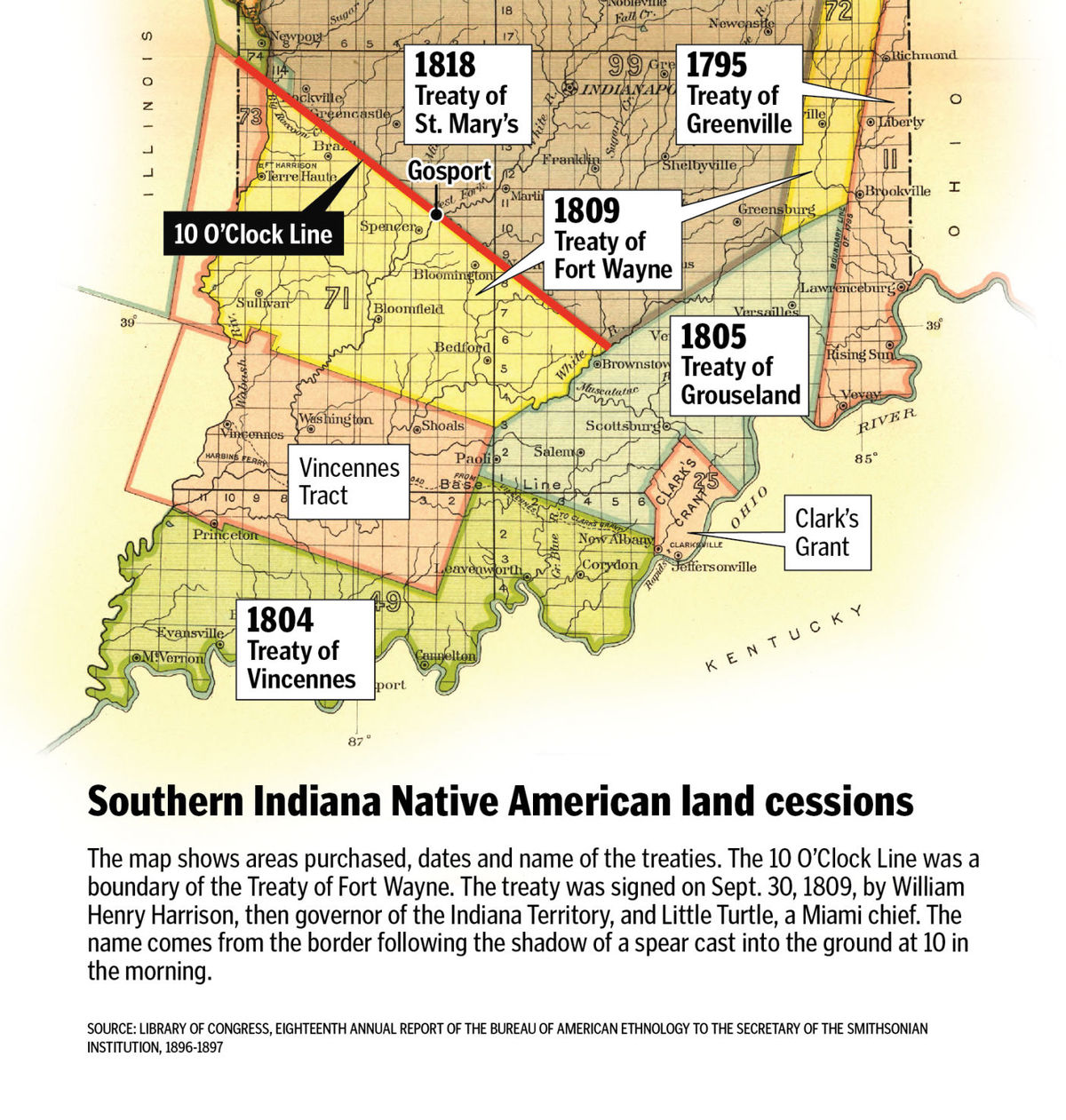 The Indian tribes Potawatomi, Weas, Delawares, and the Miamis were represented in this treaty which saw 8 million acres of land in central Indiana be purchased by the government. The land in north and northeast Monroe County was open to sale after this treaty. Also known as the New Purchase. The Indian tribes Potawatomi, Weas, Delawares, and the Miamis were represented in this treaty which saw 8 million acres of land in central Indiana be purchased by the government. The land in north and northeast Monroe County was open to sale after this treaty. Also known as the New Purchase.
Source: Russ F. Lockridge, Sr., The Story of Indiana (Oklahoma City, OK: Harlow Publishing Corp, 1951), 198.
|
| Brick Courthouse Work Begun 1819, Jun |
A contract with John Ketchum is signed for construction of a new permanent courthouse on the public square.
Source: Charles Blanchard, Counties of Morgan, Monroe, and Brown, Indiana (Chicago: F. A. Battey & Co, 1884), 383.
|
| Log schoolhouse built 1819, Jul |
A log schoolhouse is built near Seventh Street and College Avenue.
Source: Charles Blanchard, Counties of Morgan, Monroe, and Brown, Indiana (Chicago: F. A. Battey & Co, 1884), 470. map
|
| State legislature chooses Monroe County for state seminary 1820, Jan 20 |
The state legislature passes an ordinance to locate two Indiana townships, one in Monroe County, for state seminaries.
Source: Charles Blanchard, Counties of Morgan, Monroe, and Brown, Indiana (Chicago: F. A. Battey & Co, 1884), 477. more...
|
| Seward & Company Opens 1821, Sep |
Austin Seward and family move from Kentucky to Bloomington and open a blacksmith shop on the southeast corner of what is now 7th and Walnut streets. The company is in business for 161 years. |
| Monroe County boundary change 1821, Dec 31 |
Land purchased under the the Indian Treaty of St. Mary's in 1818 opens a portion of the county north and east of the "Ten o'clock Line" which had been the original boundary. The added land is opened for settlement.
Source: George Pence and Nellie C. Armstrong, Indiana Historical Collections Vol XIX: Indiana Boundaries (Indianapolis: Wm. B. Burford Printing Co., 1967), 602-603.
|
| Baynard Hall first professor and principal 1823, Nov |
Source: David Demarre Banta, History of Indiana University (Bloomington: Indiana Memorial Volume, 1921), 20-24.
|
| "Indiana Gazette": first printing 1824, Oct 30 |
The "Indiana Gazette", moved from Corydon to Bloomington, is the first newspaper printed here.
Source: Donald Carmony, "Pioneer Press in Indiana," Indiana History Bulletin., October 1, 1954, 208-209.
|
| Indiana Seminary opens its doors 1825, Apr 3 |
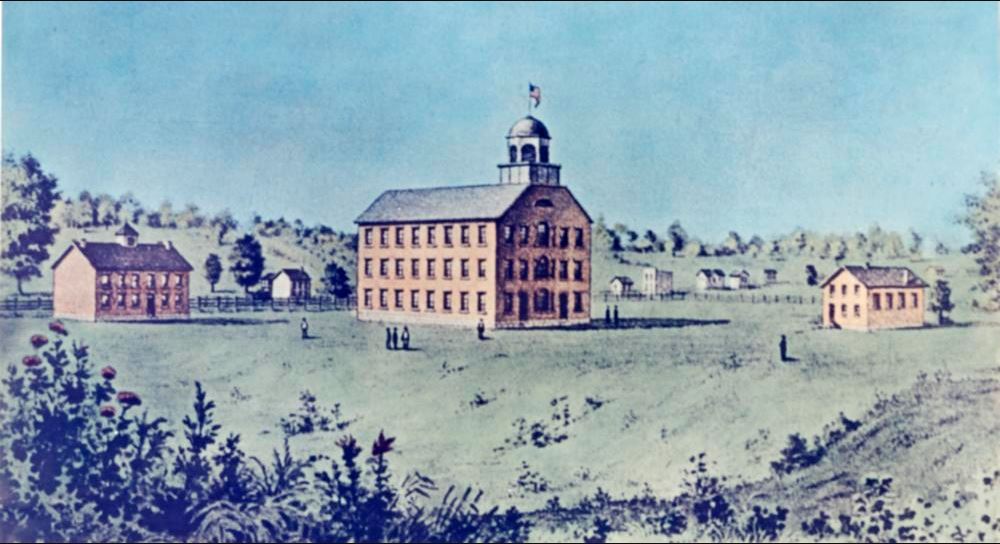 Begun in 1822, construction of the Seminary Building ended in 1824. It is reported in the Indiana "Gazette" and by Professor John Harney that the date of April 3, 1825 was the opening date for admitting ten boys. Among them is Joseph A. Wright, tenth governor of Indiana. The building was sold and razed in 1858. Begun in 1822, construction of the Seminary Building ended in 1824. It is reported in the Indiana "Gazette" and by Professor John Harney that the date of April 3, 1825 was the opening date for admitting ten boys. Among them is Joseph A. Wright, tenth governor of Indiana. The building was sold and razed in 1858.
Source: Thomas D. Clark, Indiana University: Midwestern Pioneer, Volume 1 Early Years (Bloomington & London: Indiana University Press, 1970), 31.
|
| Salt Creek township established 1825, May |
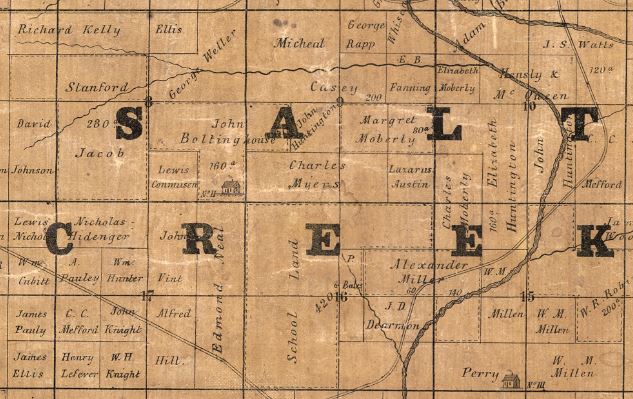 Salt Creek township in eastern and southeastern Monroe county is established by the county commissioners. [Image from 1856 plat map.] Salt Creek township in eastern and southeastern Monroe county is established by the county commissioners. [Image from 1856 plat map.]
Source: Monroe County, IN, Monroe County Commissioners Book \'B\' (Bloomington: Monroe County, 1832), 19.
|
| Courthouse completed 1826 |
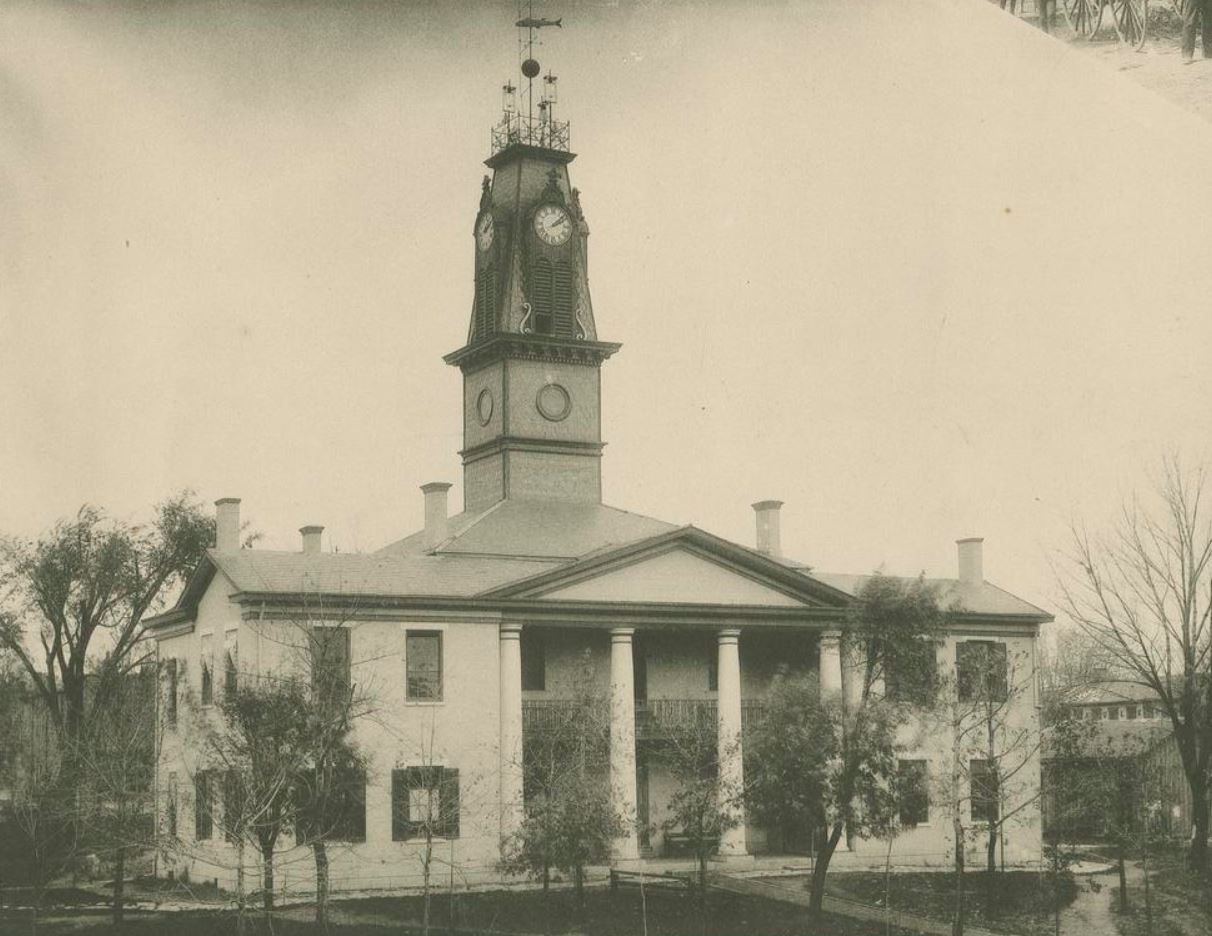 The second county courthouse on the square in Bloomington is completed and occupied. The second county courthouse on the square in Bloomington is completed and occupied.
|
| First commercial quarry opens 1827 |
First commercial limestone quarry is opened by Richard Gilbert, 3/4 mi south of Stinesville, Monroe County.
Source: "Limestone Foundation For Stinesville," Joseph A Batchelor, An Economic History of the Indiana Oolitic Limestone Industry (Indiana University Bloomington school of business, 1944), July 6, 1955, 8.
|
| Bloomington incorporated as town 1827, Mar 5 |
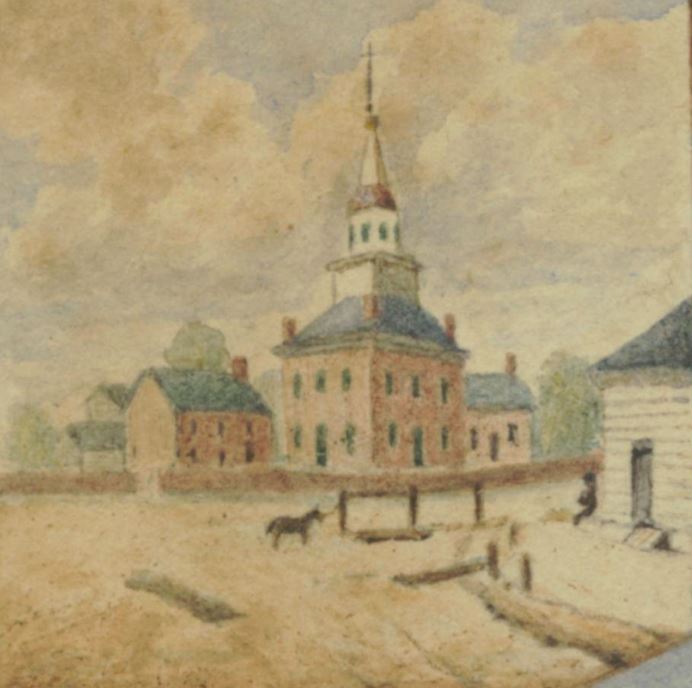 Citizens of Bloomington meet at the courthouse to vote on incorporating the county seat as a town. The voice vote was 18 for and 3 against incorporation. Election of trustees would be subsequently held. Citizens of Bloomington meet at the courthouse to vote on incorporating the county seat as a town. The voice vote was 18 for and 3 against incorporation. Election of trustees would be subsequently held.
Source: Charles Blanchard, The Heritage Collection History and Biography: Counties of Morgan, Monroe and Brown, Indiana (F.A. Battey & Co. Publishers, 1884), 463. more...
|
| Indiana Seminary becomes Indiana College 1828, Jan 24 |
Indiana College established from Indiana Seminary.
Source: Woodburn, James A. History of Indiana University Volume I, 1820-1902. Bloomington, IN: Indiana University, 1940. p32
|
| Andrew Wylie elected president of Indiana College 1828, Oct 5 |
Source: Charles Blanchard, Counties of Morgan, Monroe, and Brown, Indiana (Chicago: F. A. Battey & Co, 1884), 477. more...
|
| Richland Township established 1829, Jul |
Richland township is established from Bean Blossom township.
Source: Monroe County, IN, Monroe County Commissioners Book \'B\' (Bloomington: Monroe County, 1832), 207.
|
| Washington Township Established 1829, Jul |
Washington township, named to honor George Washington, is established in northern Monroe County by ordinance of the county commissioners.
Source: Monroe County, IN, Monroe County Commissioners Book \'B\' (Bloomington: Monroe County, 1832), 207.
|
| Perry Township established 1830, May |
Perry township is established from the original Seminary township created for use as the State College lands. Perry is named for Oliver Perry, a naval hero in the War of 1812.
Source: Monroe County, IN, Monroe County Commissioners Book \'B\' (Bloomington: Monroe County, 1832), 246.
|
| Benton Township created from Jackson township 1833, May |
The new Benton township is created from Jackson township by a line "dividing the land and people as equally from north to south as maybe allowing the eastern part to retain the name of Jackson and calling the western half Benton." Thomas Hart Benton, the US senator from Missouri, is the new township's namesake.
Source: Monroe County, IN, Monroe County Commissioners Book \'C\' (Bloomington: Monroe County, 1839), 111-112.
|
| Richland Platted and Renamed Ellettsville 1837, Feb 13 |
Richland is mapped and platted but renamed Ellettsville when the name of Richland has already been used as an Indiana post office. The town is renamed for Edward Ellett, an original settler and businessman.
Source: Commissioners Book F: Monroe County, Indiana, 117.
|
| Van Buren township established 1837, Mar |
Van Buren township, named for President Martin Van Buren, is established in western Monroe County from Richland and Indian Creek townships.
Source: Monroe County, IN, Monroe County Commissioners Book \'C\' (Bloomington: Monroe County, 1839), 275.
|
| Request for poor farm 1838 |
Citizens of Monroe County ask county commissioners for a poor farm.
Source: Pam Service, "Karst Farm Park Once Site of Poor Farm," Herald Telephone, May 3, 1990.
|
| Indiana College becomes Indiana University 1838, Feb 13 |
 Indiana State Legislative act adopted changing Indiana College to Indiana University. Indiana State Legislative act adopted changing Indiana College to Indiana University.
Source: James Albert Woodburn, History of Indiana University: Volume I: 1820-1902 (Bloomington: Indiana University, 1940), 110.
|
| Bloomington charter enacted 1845, Jan 13 |
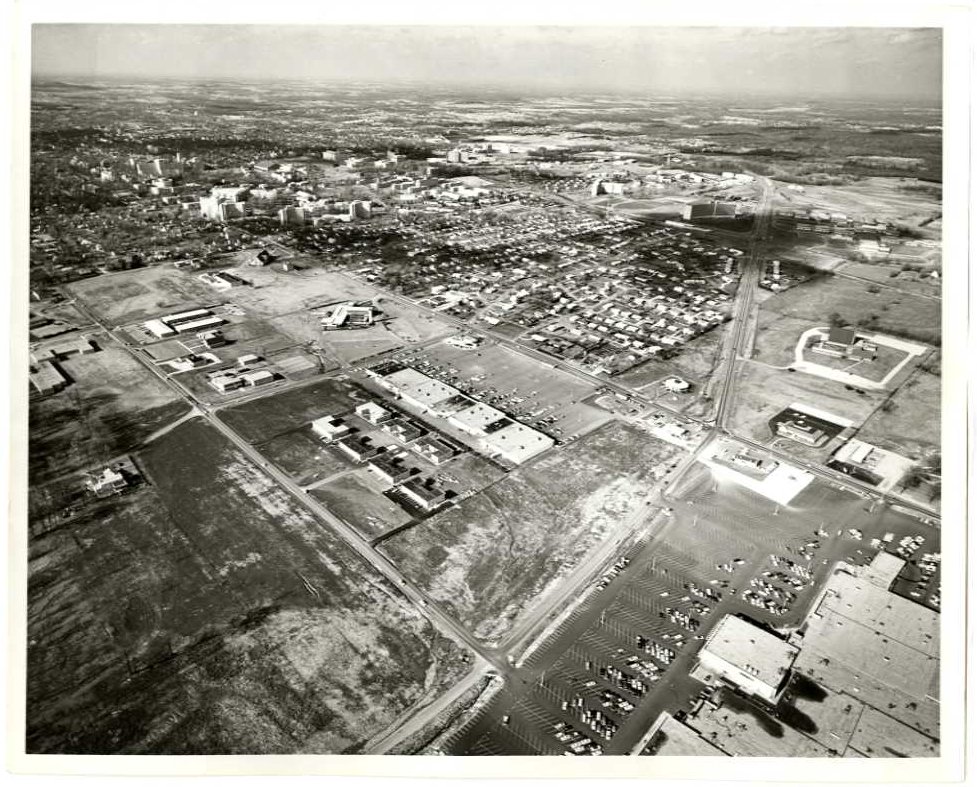 The General Assembly of the state of Indiana passes the charter, creating the town of Bloomington, establishing boundaries, and laying down governing laws of the town. The General Assembly of the state of Indiana passes the charter, creating the town of Bloomington, establishing boundaries, and laying down governing laws of the town.
Source: Charter of the Town of Bloomington (1845)
|
| Marion township created 1845, Aug |
Marion township is created from the northern part of Benton township in northeast Monroe County. The southern boundary of Marion is along the Bean Blossom creek.
Source: Monroe County, IN, Monroe County Commissioners Book \'D\' (Bloomington: Monroe County, 1846), 539.
|
| Wolfe begins selection of land 1852 |
A public notice is printed that Benjamin Wolfe, Esq. and a county agent in Monroe County is authorized to select 4166 acres of land, by virtue of congress, approved July 12, 1852, for the benefit of the State University.
Source: Daily Ohio Stateman, November 27, 1852.
|
| Common school fund is established 1852 |
The Indiana state legislature passes a law establishing common school funds, ending the tuition system.
Source: Fletcher Harper Swift, A History of Public Permanent School Funds in the United States 1795-1905 (New York: Henry Holt and Company, 1911), 261.
|
| Railroad comes to Ellettsville 1853 |
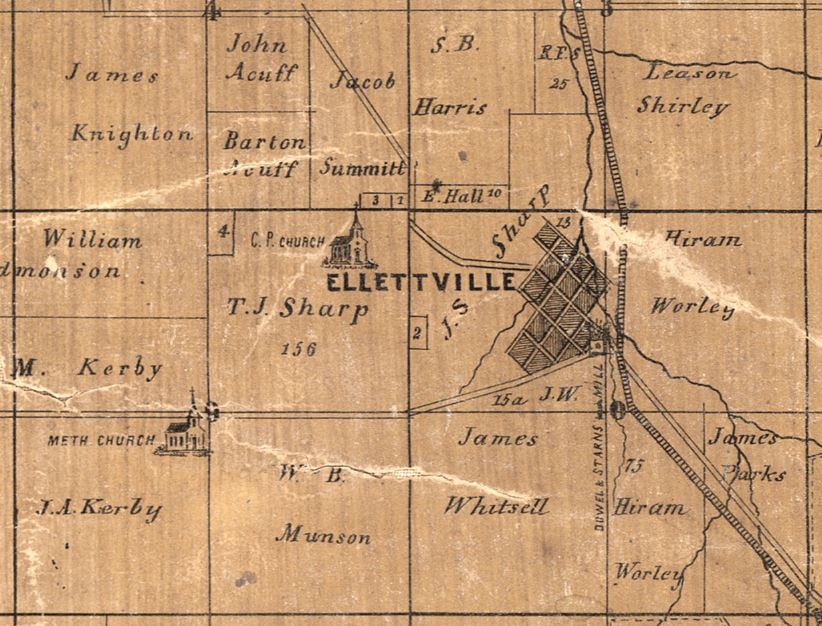 The Louisville, New Albany, and Chicago Railroad (later known as the Monon) first comes through Ellettsville. J.M. Campbell is the first railroad agent, and Edward Moberly serves as an a agent and the first telegrapher. The Louisville, New Albany, and Chicago Railroad (later known as the Monon) first comes through Ellettsville. J.M. Campbell is the first railroad agent, and Edward Moberly serves as an a agent and the first telegrapher.
Source: Marion Jacobs, "Ellettsville A Village Grows Where Once a Wilderness Stood Untouched," The Journal, September 12, 1962, 1. map
|
| Railroad enters Bloomington 1853, Oct 11 |
The New Albany and Salem railroad is built into Bloomington. The railroad was finished through the county by the following summer. A celebration of opening was held on July 4, 1854 in New Albany.
Source: George W. Hilton, Monon Route (Berkeley, CA: Howell-North Books, 1978), 18.
|
| J.D. Showers comes to Bloomington 1856 |
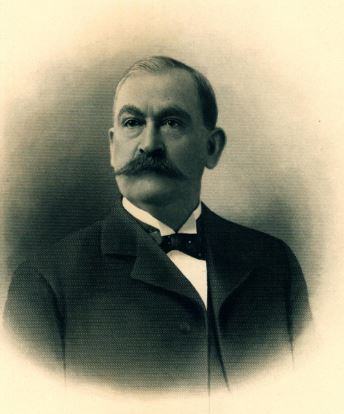 J.D. Showers arrives in Bloomington. He was born in Fort Wayne, Indiana in 1841. He takes up the trade of cabinet making and establishes the Showers Brothers Company in 1862. J.D. Showers arrives in Bloomington. He was born in Fort Wayne, Indiana in 1841. He takes up the trade of cabinet making and establishes the Showers Brothers Company in 1862.
Source: History of Lawrence and Monroe Counties, Indiana: Their People, Industries, and Institutions (Indianapolis: B. F. Bowen & Co., 1914), 609. more...
|
| City government dissolved 1858, Jan |
Bloomington citizen's held a vote to dissolve the city as a corporation. They were motivated by unfair taxes and poor road conditions.
Source: Charles Blanchard, The Heritage Collection History and Biography: Counties of Morgan, Monroe and Brown, Indiana (F.A. Battey & Co. Publishers, 1884), 465,466.
|
| Catholics celebrate first Mass in church 1864, Jul 19 |
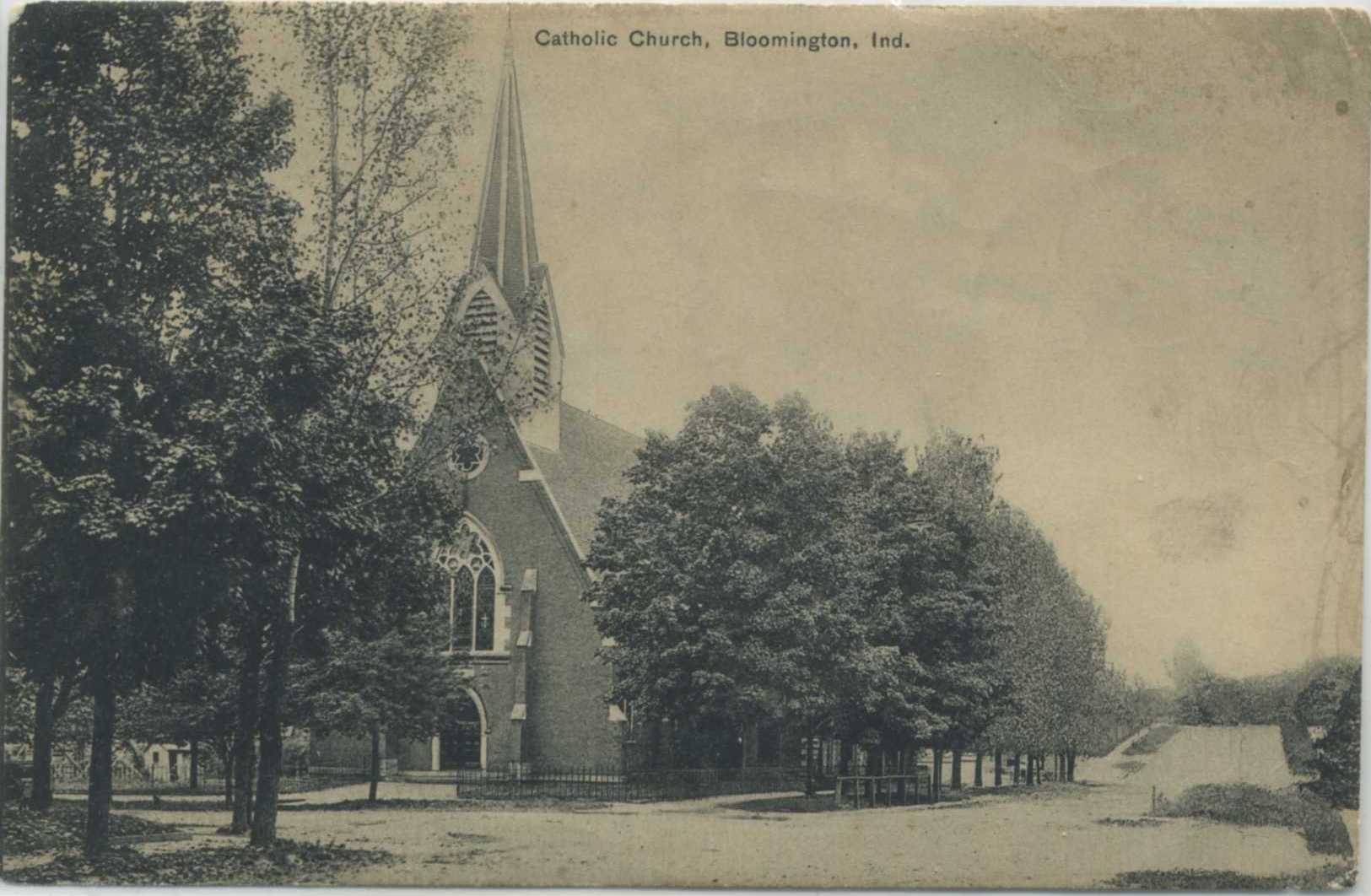 St. Patrick's Catholic Church sells two lots on west Fourth Street bought previously, to buy for $600 the Baptist church on the S.E. corner of Fourth and Madison. Church is later called St. Charles. St. Patrick's Catholic Church sells two lots on west Fourth Street bought previously, to buy for $600 the Baptist church on the S.E. corner of Fourth and Madison. Church is later called St. Charles.
Source: Mary A Waldron Ph. D., History of St. Charles Catholic Church: Including an Early Synoptic History of the County and City (Bloomington: Catholic Diocese, 1934), 22.
|
| Annual appropriations begin for IU 1867, Mar 8 |
The Indiana legislature enacts annual appropriations for Indiana University
Source: IU Chronology, Libraries.edu, 1867. more...
|
| First woman I.U. student 1867, Sep |
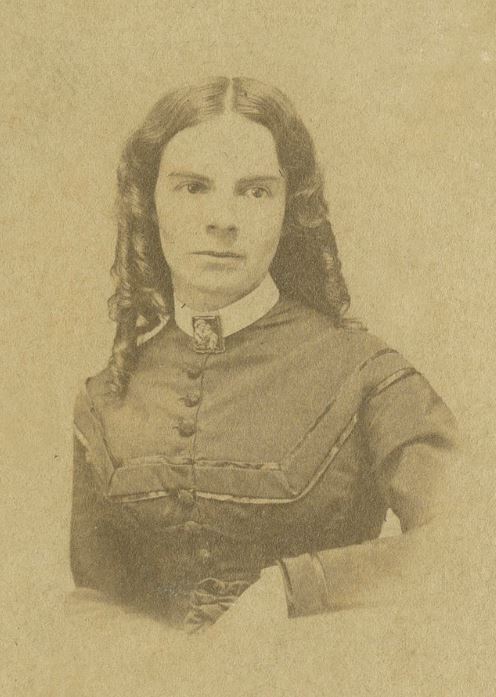 The first woman student, Sarah Parke Morrison, is admitted to Indiana University. By 1871 there were 32 women. They were admitted by the same criteria, and studied for the same degrees, as men. Morrison became an Adjunct Professor of English Literature. Morrison Hall in the Wells Quadrangle is named for her. The first woman student, Sarah Parke Morrison, is admitted to Indiana University. By 1871 there were 32 women. They were admitted by the same criteria, and studied for the same degrees, as men. Morrison became an Adjunct Professor of English Literature. Morrison Hall in the Wells Quadrangle is named for her.
Source: Thornbrough, Emma Lou. Indiana in the Civil War Era, 1850-1880. Vol. 3. Indianapolis: Indiana Historical Bureau & Historical Society, 1965. Pp. 507-08. more...
|
| Opera House is built 1868 |
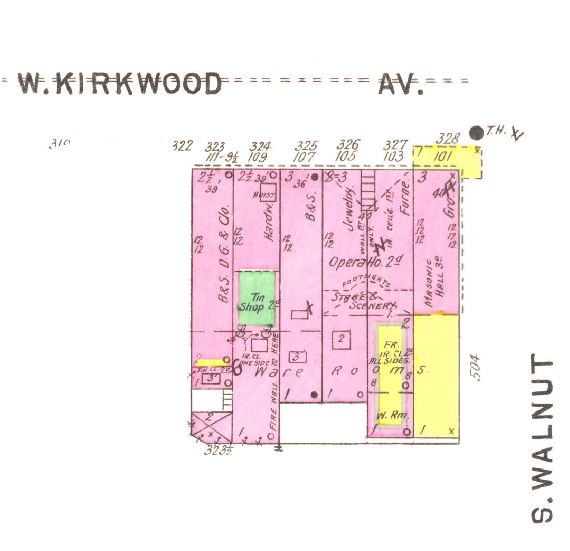 The Old Opera house is built at 103-105 W. Kirkwood on the south side of the square. Later the building would be purchased by the Waldron family and commercial businesses such as Bloomington Hardware would locate there.
(Image from the 1898 Sanborn Map.) The Old Opera house is built at 103-105 W. Kirkwood on the south side of the square. Later the building would be purchased by the Waldron family and commercial businesses such as Bloomington Hardware would locate there.
(Image from the 1898 Sanborn Map.)
Source: City of Bloomington Interim Report: Indiana Historic Sites and Structures Inventory (Bloomington: City of Bloomington, 2004), 50. map
|
| City prepares for total eclipse 1869, Aug |
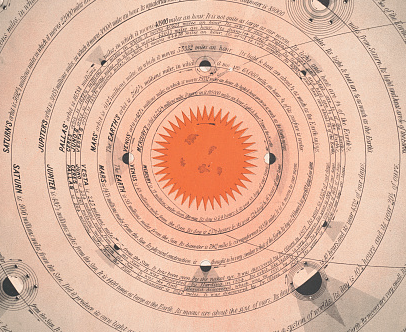 A newspaper publishes an account for how the city prepares for the total solar eclipse on August 7th. "An inhabitant of the Salt Creek hills came to town last Saturday, and having heard so much of the Eclipse, he stopped in the Court House yard, placed his eye to the tube of the octagonal structure, which at present lies upon its side in the northwest corner, and looked long and anxiously through what the 'rock beaters' told him was a telescope, expecting momentarily to see the great obscuration. After wearying his patience, and skinning his nose against a nail, he left town, curing the Eclipse as an infernal Republican electioneering dodge." A newspaper publishes an account for how the city prepares for the total solar eclipse on August 7th. "An inhabitant of the Salt Creek hills came to town last Saturday, and having heard so much of the Eclipse, he stopped in the Court House yard, placed his eye to the tube of the octagonal structure, which at present lies upon its side in the northwest corner, and looked long and anxiously through what the 'rock beaters' told him was a telescope, expecting momentarily to see the great obscuration. After wearying his patience, and skinning his nose against a nail, he left town, curing the Eclipse as an infernal Republican electioneering dodge."
|
| Central School opens 1873, Sep |
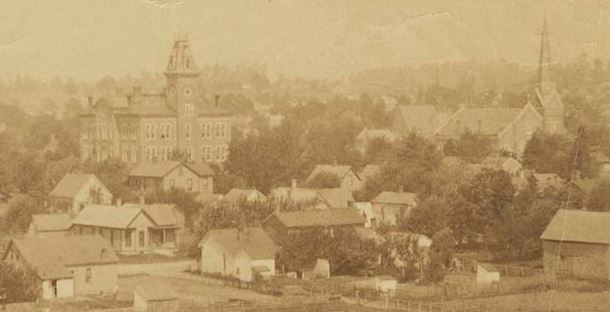 Central School opens to white children, leaving Centre School to African-American students. Central School opens to white children, leaving Centre School to African-American students.
|
| First woman superintendent elected 1874 |
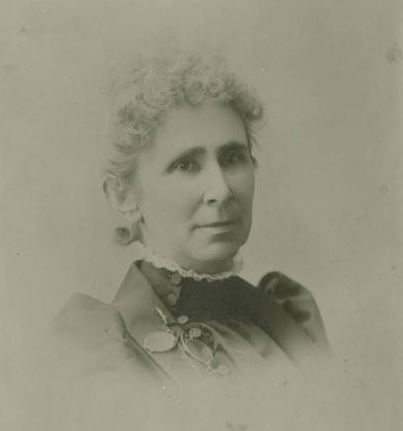 Miss Margaret McCalla is elected to succeed superintendent James Wilson. She becomes superintendent of Bloomington public schools, making her the first woman superintendent in the state of Indiana. Miss Margaret McCalla is elected to succeed superintendent James Wilson. She becomes superintendent of Bloomington public schools, making her the first woman superintendent in the state of Indiana.
Source: Alpha Chapter Delta Kappa Gamma, Margaret Hemphill McCalla: 1836-1912 (1942), 9. more...
|
| Central High School completed 1875 |
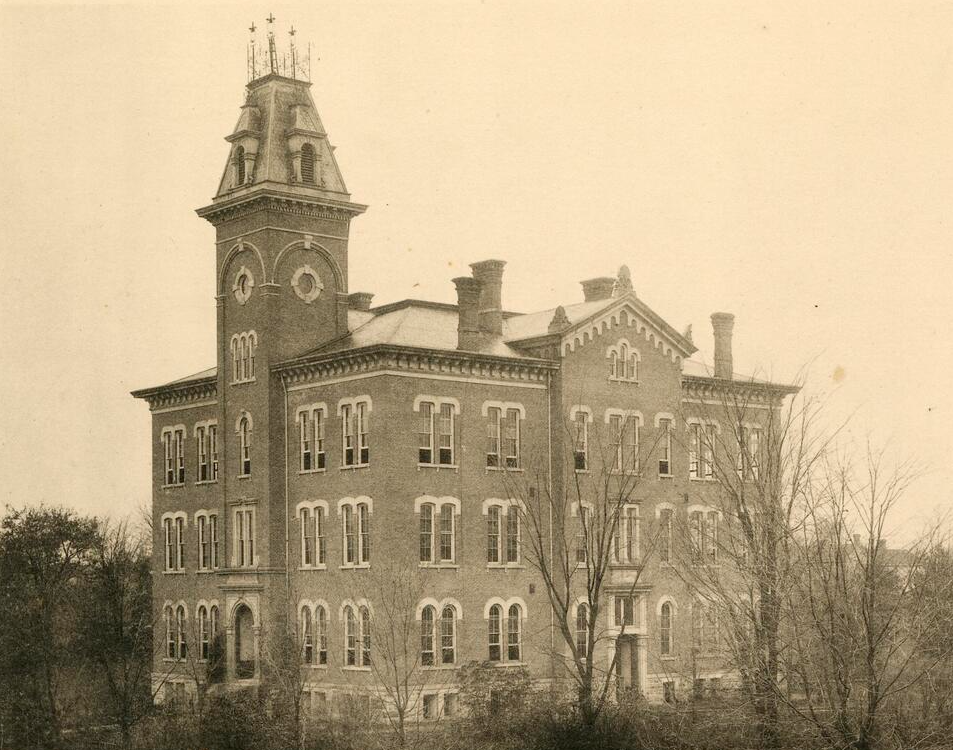 Central High School is completed on College Avenue just south of Third Street near the Methodist Church. Central High School is completed on College Avenue just south of Third Street near the Methodist Church.
|
| Bloomington narrowly incorporated as a city 1876, Jul |
The citizens of Bloomington vote 184 for to 169 against to incorporate the town as a city.
Source: Charles Blanchard, The Heritage Collection History and Biography: Counties of Morgan, Monroe and Brown, Indiana (F.A. Battey & Co. Publishers, 1884), 467.
|
| Fire destroys west side of square 1883, Mar 16 |
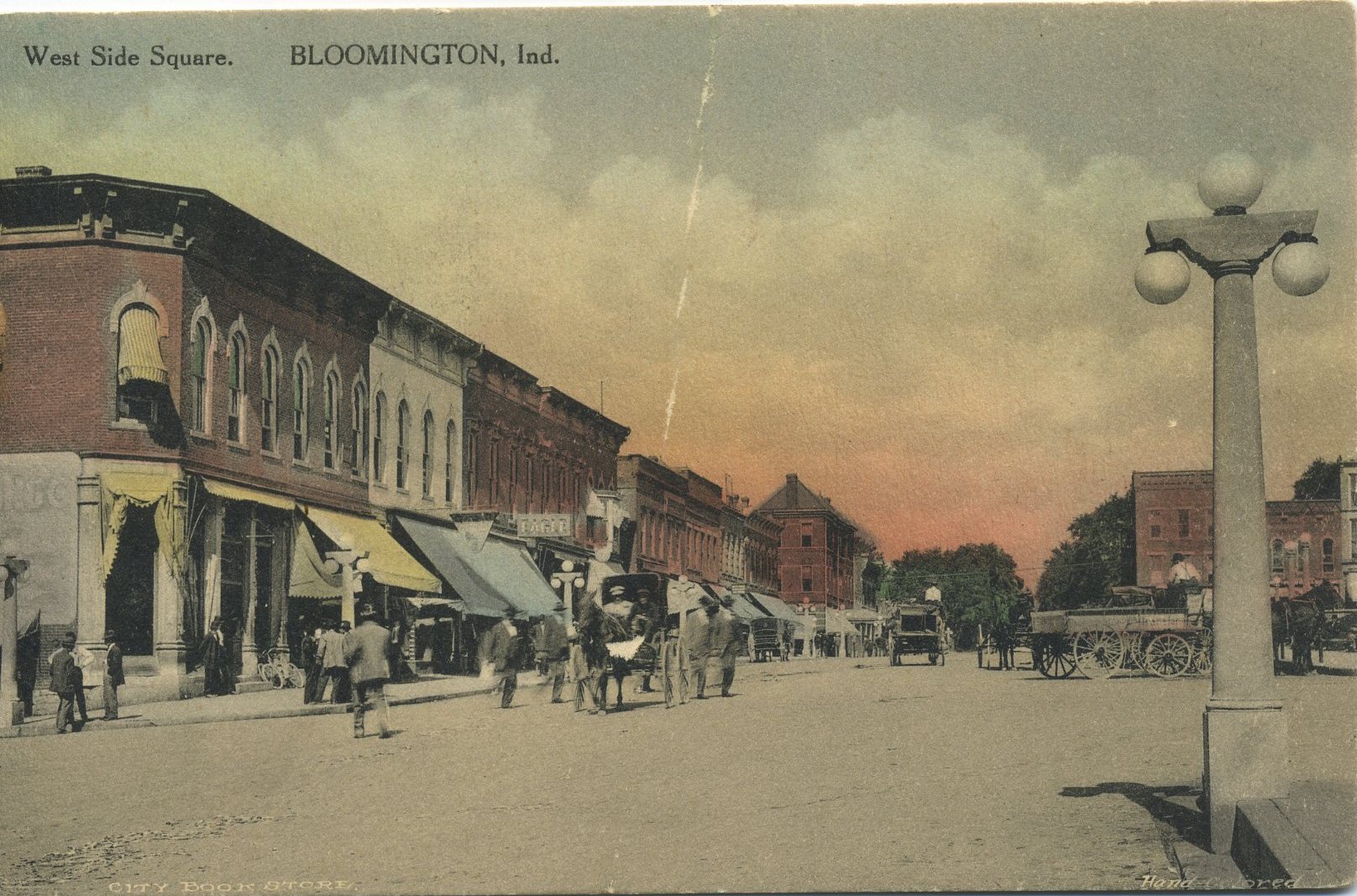 Fire destroys west side of square. Fire destroys west side of square.
Source: "After the Fire. Counting up the Loss." Bloomington Telephone (Bloomington, IN), March 24, 1883.
|
| Fire destroys Science Hall 1883, Jul 12 |
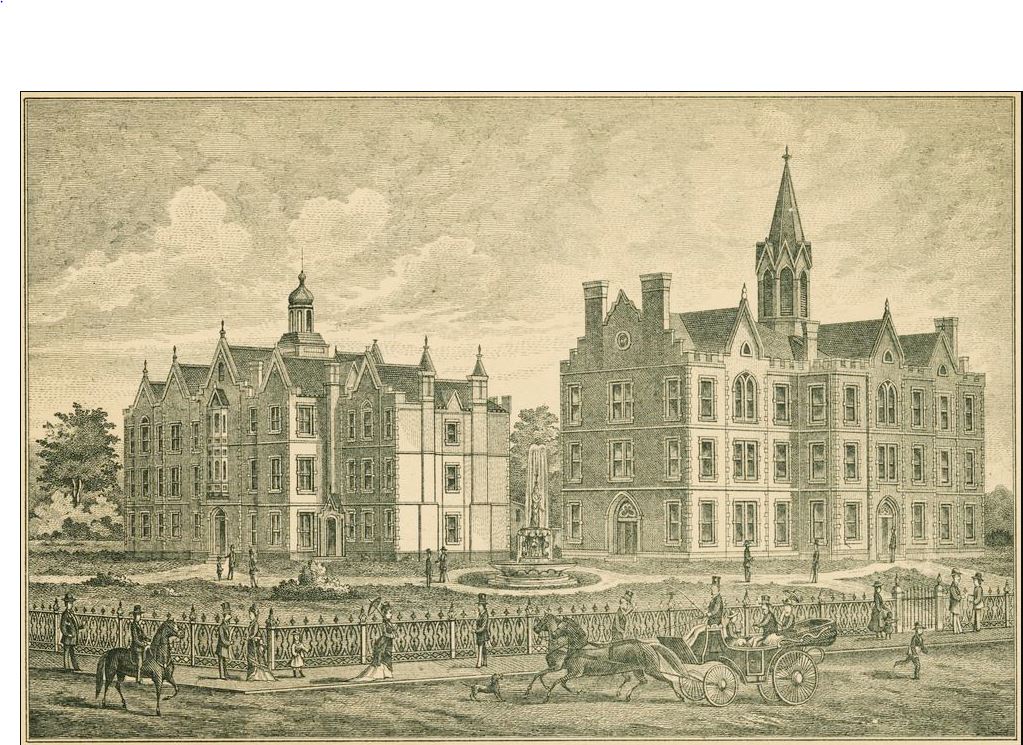 A bolt of lightning strikes the Science building on the Seminary grounds around 6 p.m. setting fire to the library of Professor, and later President, David Starr Jordan. The fire smolders until 8 the following morning, leaving the contents of the building destroyed. A bolt of lightning strikes the Science building on the Seminary grounds around 6 p.m. setting fire to the library of Professor, and later President, David Starr Jordan. The fire smolders until 8 the following morning, leaving the contents of the building destroyed.
Source: D.C. Miller, "Old Bloomington," Daily Telephone, June 25, 1947. more...
|
| Dunn sells 20 acres to IU 1884, Feb 4 |
Source: Thomas D. Clark, Indiana University: Midwestern Pioneer, Volume 1 Early Years (Bloomington & London: Indiana University Press, 1970), 140.
|
| New buildings at Dunn's Woods 1885, Dec |
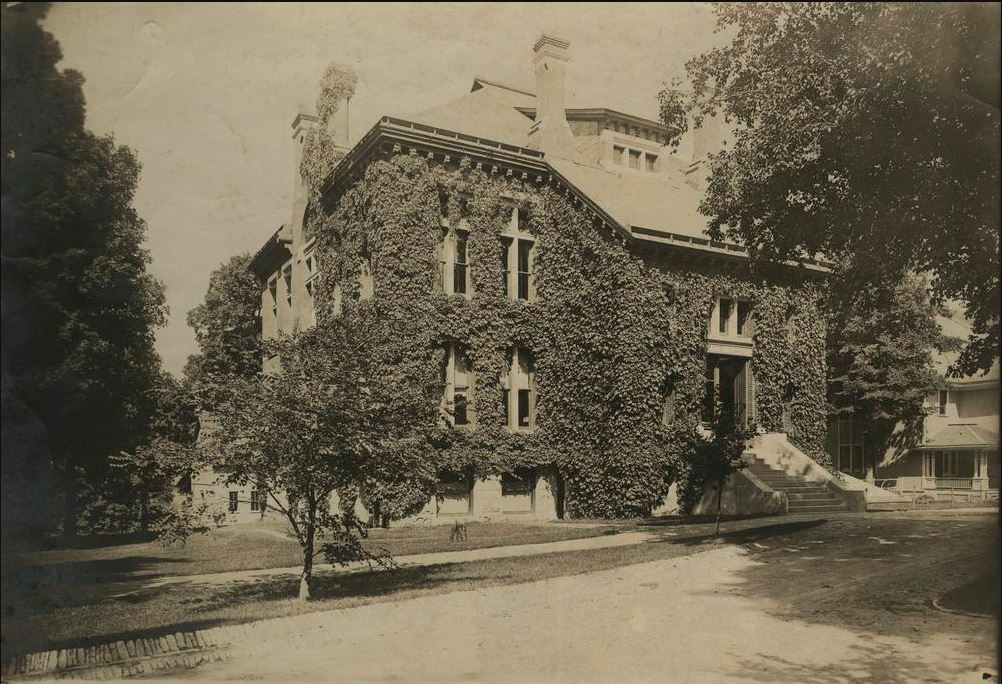 Indiana University moved to Dunn Woods (present) location after fire at Seminary Square (old) location at Second and College; the first 2 buildings, Owen Hall and Wylie Hall are mainly brick with Indiana Limestone for sills, steps, and some trim. The groundbreaking for both buildings was April 2, 1884. Indiana University moved to Dunn Woods (present) location after fire at Seminary Square (old) location at Second and College; the first 2 buildings, Owen Hall and Wylie Hall are mainly brick with Indiana Limestone for sills, steps, and some trim. The groundbreaking for both buildings was April 2, 1884.
Source: Thomas D. Clark, Indiana University: Midwestern Pioneer, Volume 1 Early Years (Bloomington & London: Indiana University Press, 1970), 141. more...
|
| Electric lights planned 1886, Jun 10 |
The Bloomington City Council, by unanimous vote, decides the Jenney Electric Light and Power Company can be given a 3-year contract to provide lights. 9 lights will be placed "in such positions as to do the most good and be operated until 12 o'clock each night, except when there is good moonlight. Three lights will be placed on the court house tower, three on the school house, one intersecting the streets at Dr. Weir's and W. B. Seward's corner Washington and 7th streets, one at the corner of Kirkwood Avenue and Lincoln street, by Miss Cherry's, on at the U.P. Church." In the 1880 US Census, Mattie R. Cherry is a school teacher running a boarding house at 418 E. Fifth Street [Kirkwood Ave.]
Source: Bloomington Telephone, June 11, 1886, 1.
|
| First intercollegiate African American athlete 1893 |
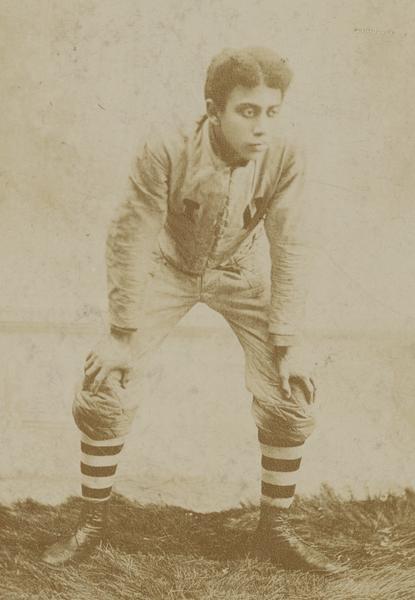 Preston Eagleson becomes the first African American athlete to be a member of an intercollegiate team at Indiana University. Eagleson is considered a prominent member of the African American community in Bloomington, and plays as a halfback during the years 1893-95. Preston Eagleson becomes the first African American athlete to be a member of an intercollegiate team at Indiana University. Eagleson is considered a prominent member of the African American community in Bloomington, and plays as a halfback during the years 1893-95.
Source: Thomas D. Clark, Indiana University: Midwestern Pioneer, Volume 1 Early Years (Bloomington & London: Indiana University Press, 1970), 321. more...
|
| GAR post established 1896 |
Grand Army of the Republic (GAR) Post No. 558 is named for John Gann and is located in Bloomington, Monroe County, Indiana.
Source: Northcott, Dennis. Indiana Civil War Veterans: Transcription of the Death Rolls of the Department of Indiana, Grand Army of the Republic, 1882-1948. St. Louis, Mo: D. Northcott, 2005. Print. Page 363
|
| First Presbyterian Church dedicated 1901, Jun 23 |
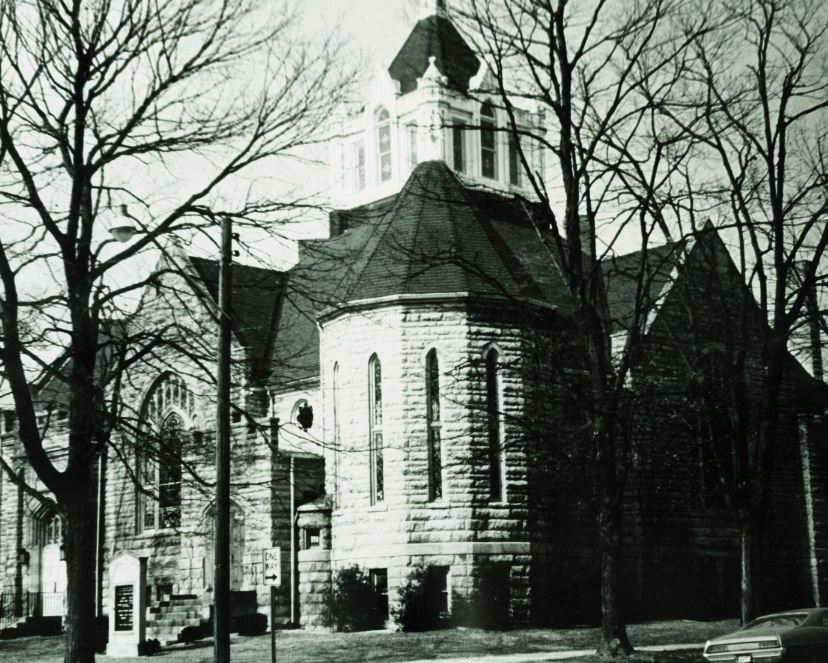 Dedicatory services are held for members of the new First Presbyterian Church, located at the corner of 6th and Lincoln Streets. The previous building on Walnut Street was destroyed in a fire in 1899. The estimated cost of the new limestone church on 6th Street was $15,791 and the final cost was $30,000. Dedicatory services are held for members of the new First Presbyterian Church, located at the corner of 6th and Lincoln Streets. The previous building on Walnut Street was destroyed in a fire in 1899. The estimated cost of the new limestone church on 6th Street was $15,791 and the final cost was $30,000.
Source: "Presbyterians Refurbishing Building: Church Mission Not Lost in Excitement," Daily Herald-Telephone, April 6, 1972, 8. more...
|
| Bryan inaugurated IU president 1903, Jan 21 |
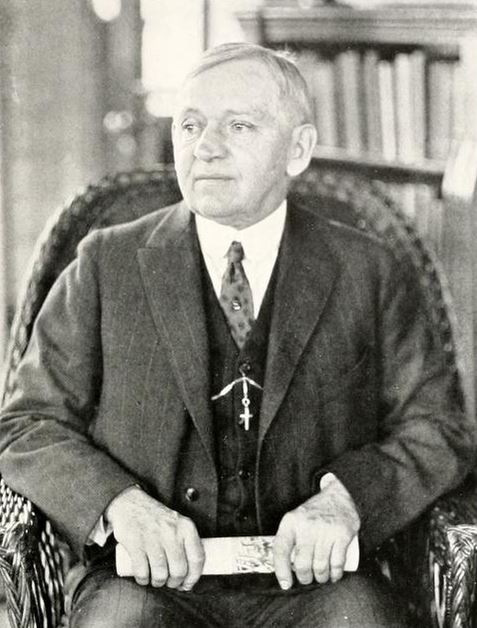 William Lowe Bryan becomes president of Indiana University. Born in Bloomington, Indiana, Bryan received degrees from IU and a Ph.D from Clark University. Bryan was previously a professor of philosophy at IU from 1885 to 1902. Bryan would serve as president for 34 years. William Lowe Bryan becomes president of Indiana University. Born in Bloomington, Indiana, Bryan received degrees from IU and a Ph.D from Clark University. Bryan was previously a professor of philosophy at IU from 1885 to 1902. Bryan would serve as president for 34 years.
Source: Indiana University, Presidential Portrait Collection: Presidents Hall (Bloomington: Indiana University, 2011) more...
|
| Death shows need for hospital 1904, Oct 28 |
C.L. Mertz, an individual employed at a camp for Italian laborers building the roadbed of Illinois Central Railroad, is killed when he falls beneath the wheels of a freight train and both his legs are crushed. He dies in the office of Doctor Harris. Mertz's death highlights the fact that no doctor's office in Bloomington is equipped for surgical cases.
Source: C. Earl East, Relive It... with C. Earl East (Mission, Kansas: Inter-Collegiate Press, Inc, 1963)
|
| Bloomington Hospital Opens 1905, Nov 29 |
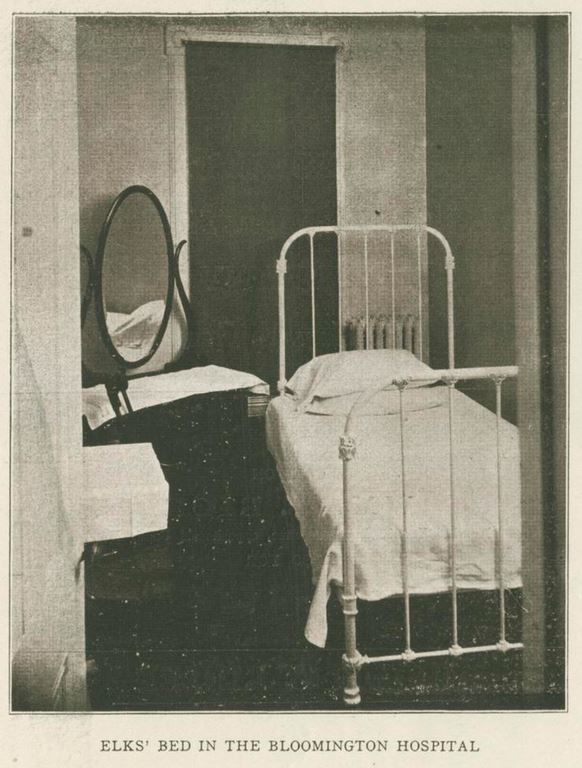 The Local Council of Women declare the new hospital, located at First and Rogers Streets, ready for occupancy. A large brick building, along with 4 1/2 acres of land, was purchased from Isaac Hopewell and remodeled for hospital use. The Local Council of Women declare the new hospital, located at First and Rogers Streets, ready for occupancy. A large brick building, along with 4 1/2 acres of land, was purchased from Isaac Hopewell and remodeled for hospital use.
|
| Courthouse cornerstone laid 1907, May 10 |
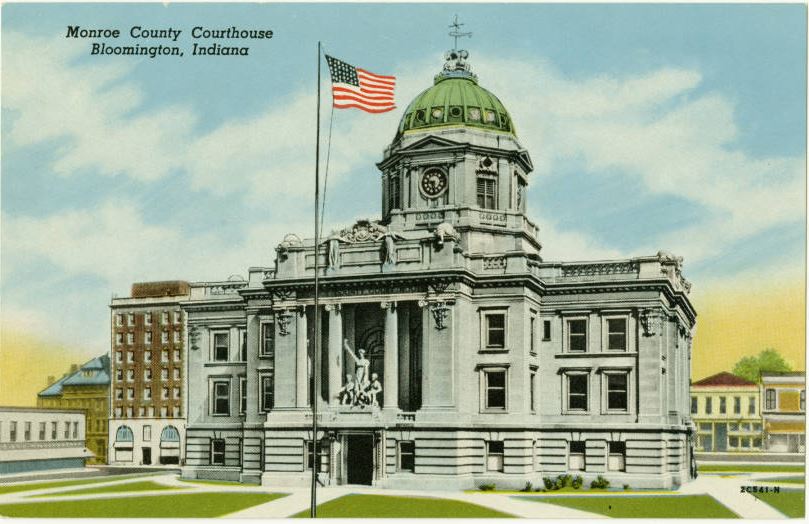 A Masonic ceremony for the new courthouse construction is witnessed by thousands. A Masonic ceremony for the new courthouse construction is witnessed by thousands.
Source: "Cornerstone Laid With Impressive Masonic Ceremony," Evening World, May 10, 1907, Front, 1. more...
|
| New courthouse dedicated 1908, Jul 4 |
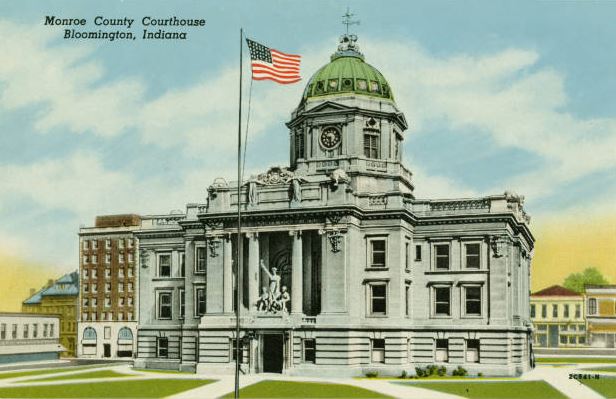 A celebration is planned to dedicate the new courthouse. A celebration is planned to dedicate the new courthouse.
Source: D. C. Miller, "Old Bloomington," The World Telephone, April 1, 1908. more...
|
| Street work around square bid June 30 1910, Jun 16 |
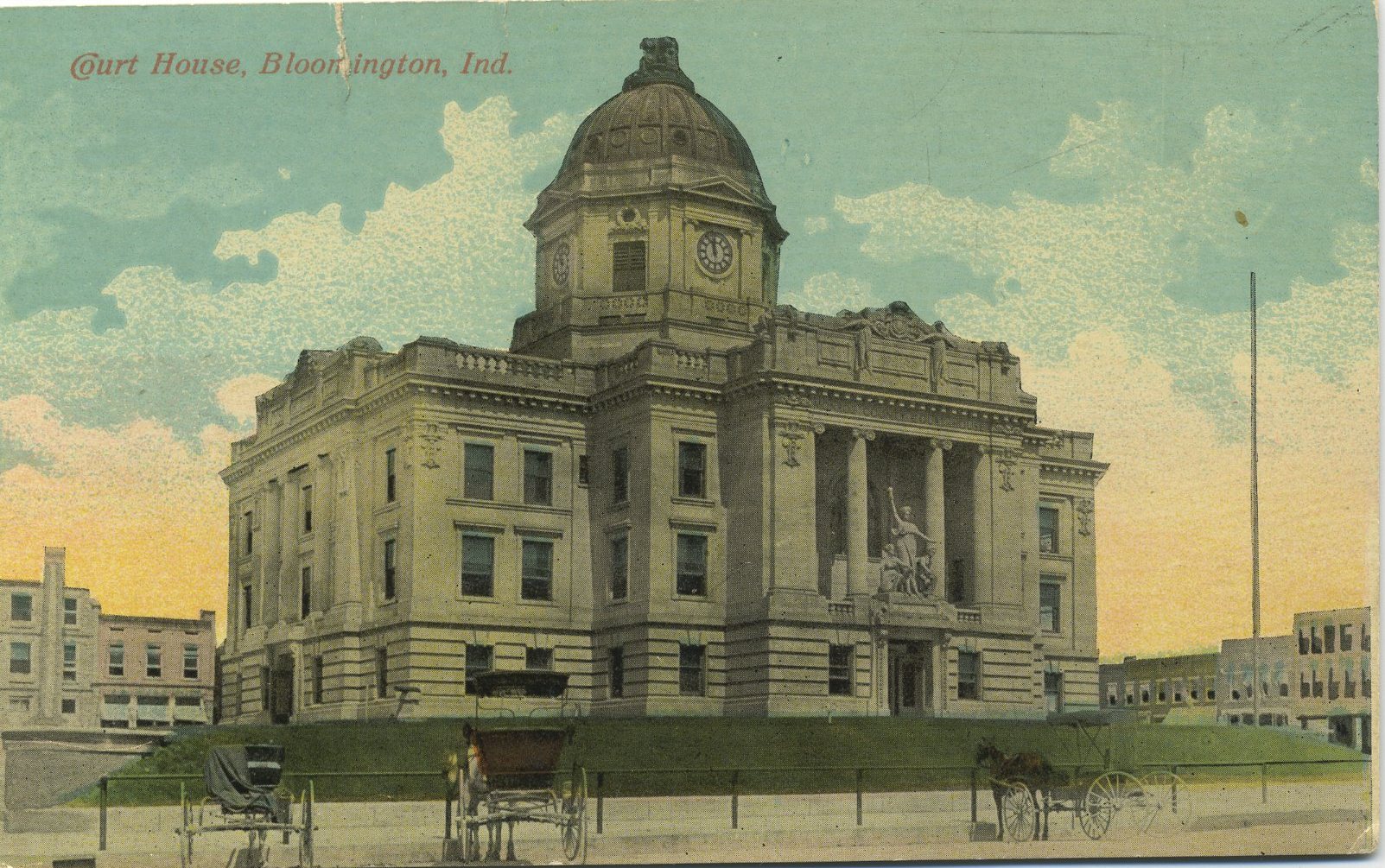 The Bloomington City Council advertised for proposals to pave the streets around the courthouse square plus one block in all directions with either Brick, Wooden Block, Asphalt,or Bithulithic. Concrete sidewalks were to be included in the bids. The Bloomington City Council advertised for proposals to pave the streets around the courthouse square plus one block in all directions with either Brick, Wooden Block, Asphalt,or Bithulithic. Concrete sidewalks were to be included in the bids.
Source: Various, Monroe County Historical Society Scrapebooks: Monroe County Clippings (Bloomington: Monroe County, 1911), 23.
|
| Bloomington High School Dedicated 1914, Dec 4 |
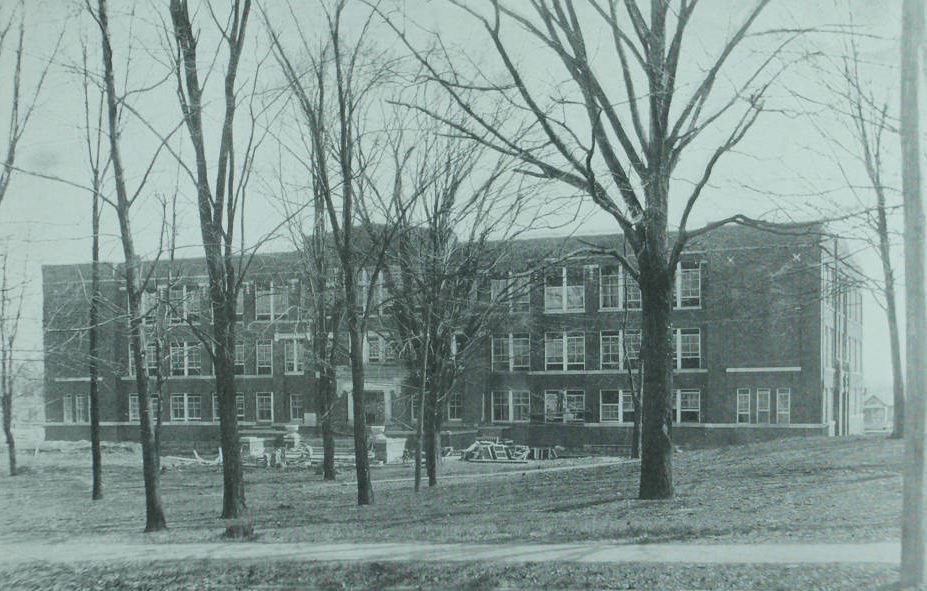 A new brick structure with a capacity of 600 students is dedicated as the new Bloomington High School. The school is located at 2nd and Walnut Streets. A new brick structure with a capacity of 600 students is dedicated as the new Bloomington High School. The school is located at 2nd and Walnut Streets.
Source: C. Roy Williams, A History of Bloomington High School: Thesis (1927), 1. more...
|
| Fire destroys Kirkwood Avenue Christian Church 1916, Dec 31 |
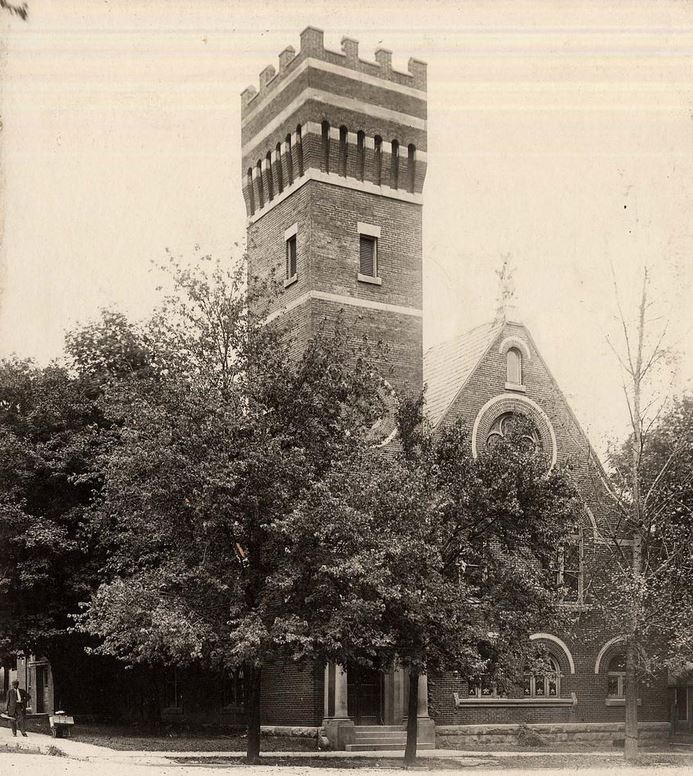 The Kirkwood Avenue Christian Church at the corner of Washington Street and Kirkwood Avenue is destroyed by a fire of unknown origin beginning on New Year's Eve. The church has been there since 1884. The Kirkwood Avenue Christian Church at the corner of Washington Street and Kirkwood Avenue is destroyed by a fire of unknown origin beginning on New Year's Eve. The church has been there since 1884.
Source: Bill Coulter, "First Christian Church, 205 East Kirkwood Avenue, Bloomington, Monroe County, Indiana," State Historic Architectural and Archaeological Research Database (SHAARD), February 3, 2015, 1. more...
|
| Bloomington wins basketball state championship 1919, Mar 15 |
Bloomington High School defeats Lafayette Jefferson at Purdue's Memorial Arena to claim the state basketball championship. Bloomington is the first southern Indiana high school to claim the title in IHSAA history.
Source: "Stamina wins victory for Bloomington team," Indianapolis News, March 17, 1919, 1, 14.
|
| First Christian dedicates church 1919, Sep 28 |
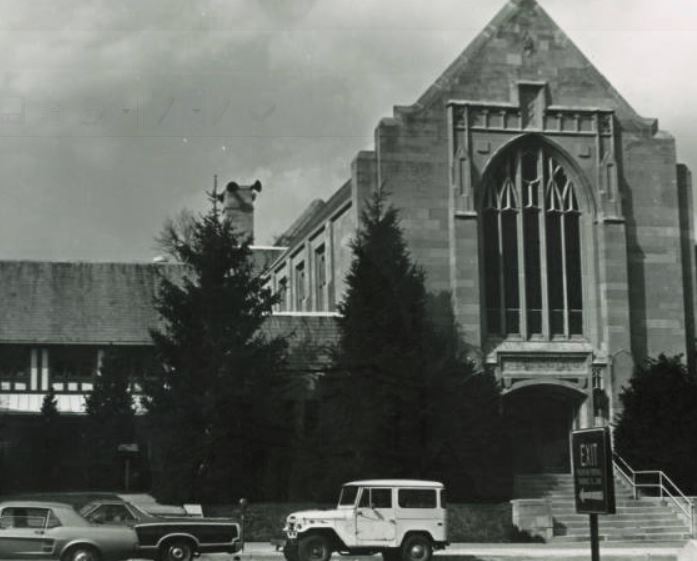 First Christian Church dedicates its new $100,000 building on Kirkwood and Washington Street in Bloomington. Services will be lead by Reverend George Shively. There will be special music and a picnic dinner in the gymnasium of the church. First Christian Church dedicates its new $100,000 building on Kirkwood and Washington Street in Bloomington. Services will be lead by Reverend George Shively. There will be special music and a picnic dinner in the gymnasium of the church.
Source: Virginia Barnard, "First Christian Church With Its Compact Organization 'Looks Ahead' Into Future," Bloomington Telephone, February 26, 1938. more...
|
| 24 limestone companies merge 1926, May 21 |
Beginning of major consolidation of companies in the Indiana limestone district with the organization of the Indiana Limestone Company merging of 24 companies.
Source: Shewmaker, Sherman N. Quarry Quest. A Field Trip Guide to the Indiana Limestone District, Monroe and Lawrence Counties, Indiana, 1991.
|
| First Methodist Church fire 1937, Apr 7 |
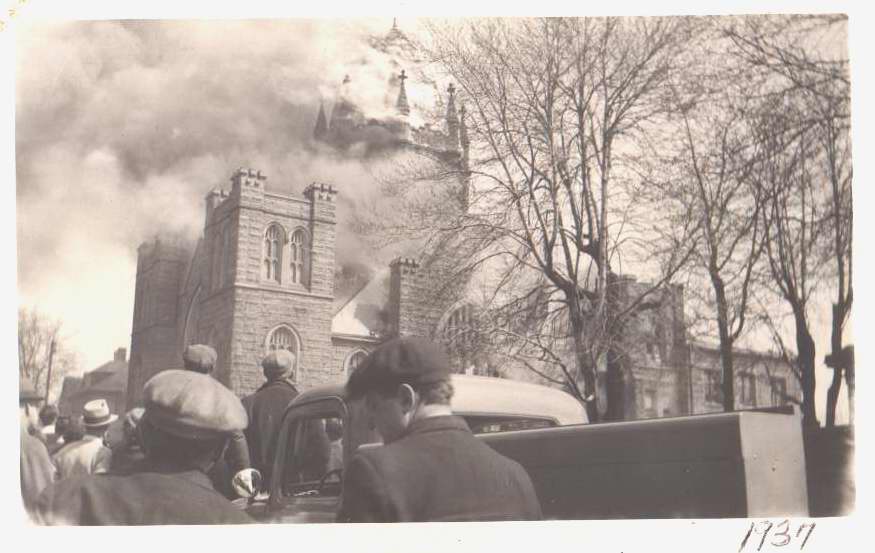 The First Methodist Church at Fourth and Washington Streets catches fire around 9:10AM and is discovered by Ellsworth Moore during his neighborhood milk delivery. The fire causes an estimated $150,000 in damages and is believed to be caused by faulty wiring. President of the church board of trustees William B. Adams states that the church was insured for $97,000 against fire. The First Methodist Church at Fourth and Washington Streets catches fire around 9:10AM and is discovered by Ellsworth Moore during his neighborhood milk delivery. The fire causes an estimated $150,000 in damages and is believed to be caused by faulty wiring. President of the church board of trustees William B. Adams states that the church was insured for $97,000 against fire.
Source: Bill Coulter, "First Methodist Church, 219 E. Fourth St., Bloomington, Monroe County, Indiana," State Historic Architectural and Archaeological Research Database (SHAARD), April 7, 1937, 8-10.
|
| Herman B Wells 11th President 1938, Mar 22 |
Source: Thomas D. Clark, Indiana University Midwestern Pioneer Vol II: In Mid Passage (Bloomington: IU Press, 1973), 403.
|
| RCA buys Showers plant 1940, Feb 22 |
RCA Manufacturing Company, Inc. announces that it has purchased the plant No. 4 of the Showers Brothers Furniture Company on south Rogers Street and plans to open a factory there that would employ between 600-700 people. RCA is the world's largest manufacturers of radio products.
Source: "1940 Chronology," Evening World, December 31, 1940. more...
|
| IU shows off cyclotron 1940, Apr 17 |
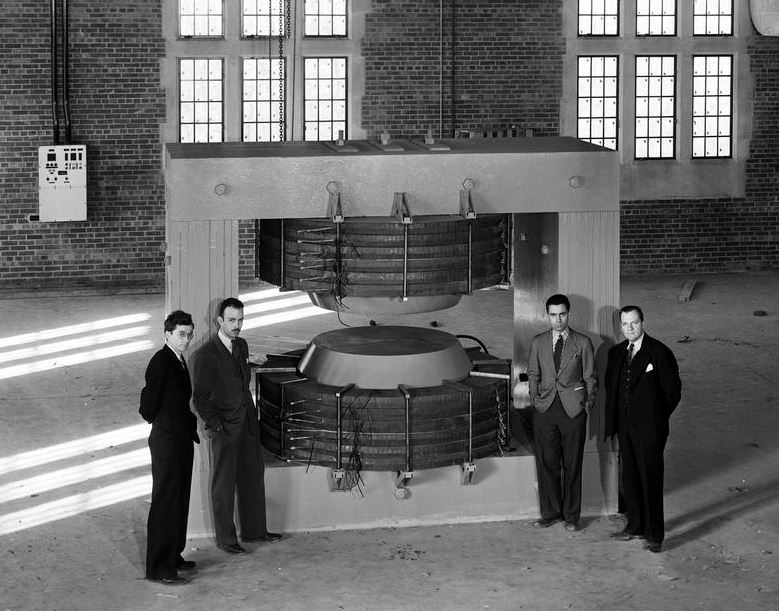 The Indiana Daily Student (IDS) publishes profile on the first cyclotron at Indiana University. The particle accelerator is used during World War II to conduct experiments as part of The Manhattan Project, which produces nuclear weapons and the atomic bomb. Faculty attached to the early cyclotron are Assistant Professor L. Jackson Laslett, Assistant Professor Franz N. D. Kurie, Assistant Professor Lawrence M. Langer and Professor Allan C. G. Mitchell. The Indiana Daily Student (IDS) publishes profile on the first cyclotron at Indiana University. The particle accelerator is used during World War II to conduct experiments as part of The Manhattan Project, which produces nuclear weapons and the atomic bomb. Faculty attached to the early cyclotron are Assistant Professor L. Jackson Laslett, Assistant Professor Franz N. D. Kurie, Assistant Professor Lawrence M. Langer and Professor Allan C. G. Mitchell.
Source: Indiana Daily Student, April 17, 1940. more...
|
| City celebrates V-E Day 1945, May 8 |
Residents dance in the streets after news of the Germans signed unconditional surrender papers at WWII Allied headquarters in Reims, France. The "Bloomington World Telephone" writes, "... having become accustomed to shadow-shaded surroundings on the square during the brownout nights, local residents all but needed sunglasses last night as the brownout was abolished by flashing, winking and rippling gleams from display lights."
Source: "Bloomington residents danced in the streets," The Herald Times, May 8, 1995.
|
| Bus crash, fire kill 16. 1949, Aug 10 |
Sixteen people burn to death after being trapped in a Greyhound bus wreck near Dolan on Hwy 37.
Source: "15 Are Dead in Bus Crash." World Telephone (Bloomington, IN), August 10, 1949.
|
| Television station begins broadcasting 1949, Nov |
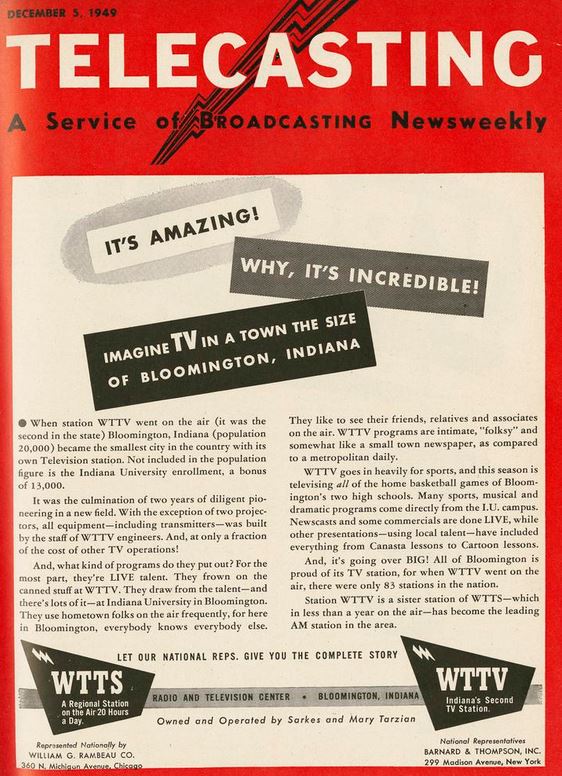 Sarkes Tarzian obtains a television license and begins broadcasting with the call letters WTTV. It is the second TV broadcast station in Indiana, located in the smallest broadcasting community in the US. Sarkes Tarzian obtains a television license and begins broadcasting with the call letters WTTV. It is the second TV broadcast station in Indiana, located in the smallest broadcasting community in the US.
Source: "WTTV To Give Test Signals Soon," Daily Telephone, February 5, 1949. more...
|
| WTTS goes live 1950, Oct 1 |
WTTS starts beaming national hook up shows via ABC into the local air waves, according to Sarkes Tarzian, Inc. The AM radio station will provide local listeners a mixture of local and national shows with the emphasis on such outstanding 'live' programs.
Source: "'Live' Network Shows; Tarizan Expanding Manufacturing Lines," Herald Telephone, September 30, 1950.
|
| Lake Lemon finished and filled 1953, Jul |
To supplement the area's water supply, Bean Blossom Reservoir is completed. The dam will ultimately trap 5 billion gallons of water and cover almost 2000 acres of land.
Source: Bruce Temple, "'Lemon-Aid' Flows Freely In Solving City Water Famine," Herald Telephone, July 9, 1953, Front Page, 1, 20.
|
| Westinghouse Electric Comes to Bloomington 1957 |
Westinghouse begins production at their plant on Curry Pike west of Bloomington.
Source: "WE Set To Fill Jobs; RCA Force Hits 3,000," Daily Herald Telephone, August 7, 1957, A, 1.
|
| Cook Inc. founded 1963, Jul |
Cook Inc. founded in the three bedroom apartment of Bill and Gayle Cook at Bart Villa, an apartment complex on East 2nd Street in Bloomington.
Source: Bob Hammel, The Bill Cook Story: Biography of a visionary Indiana billionaire (Bloomington: Indiana University Press, 2008), 77-80.
|
| Richland-Bean Blossom Schools established 1963, Jul 1 |
It is reported that the State Commission for Reorganization of School Corporations approves the new Richland Bean Blossom Metropolitan School Unit and construction of a new high school building in the district. The action of the commission was the final step in the legal procedure before the new unit becomes effective July 1st. No petitions were filed against the merger of the two townships into one school administrative unit during the 30 day waiting period.
Source: "Ellettsville, Stinesville Schools Merge," Daily Herald Telephone, May 16, 1963.
|
| Monroe Reservoir filling begins 1965, Feb 1 |
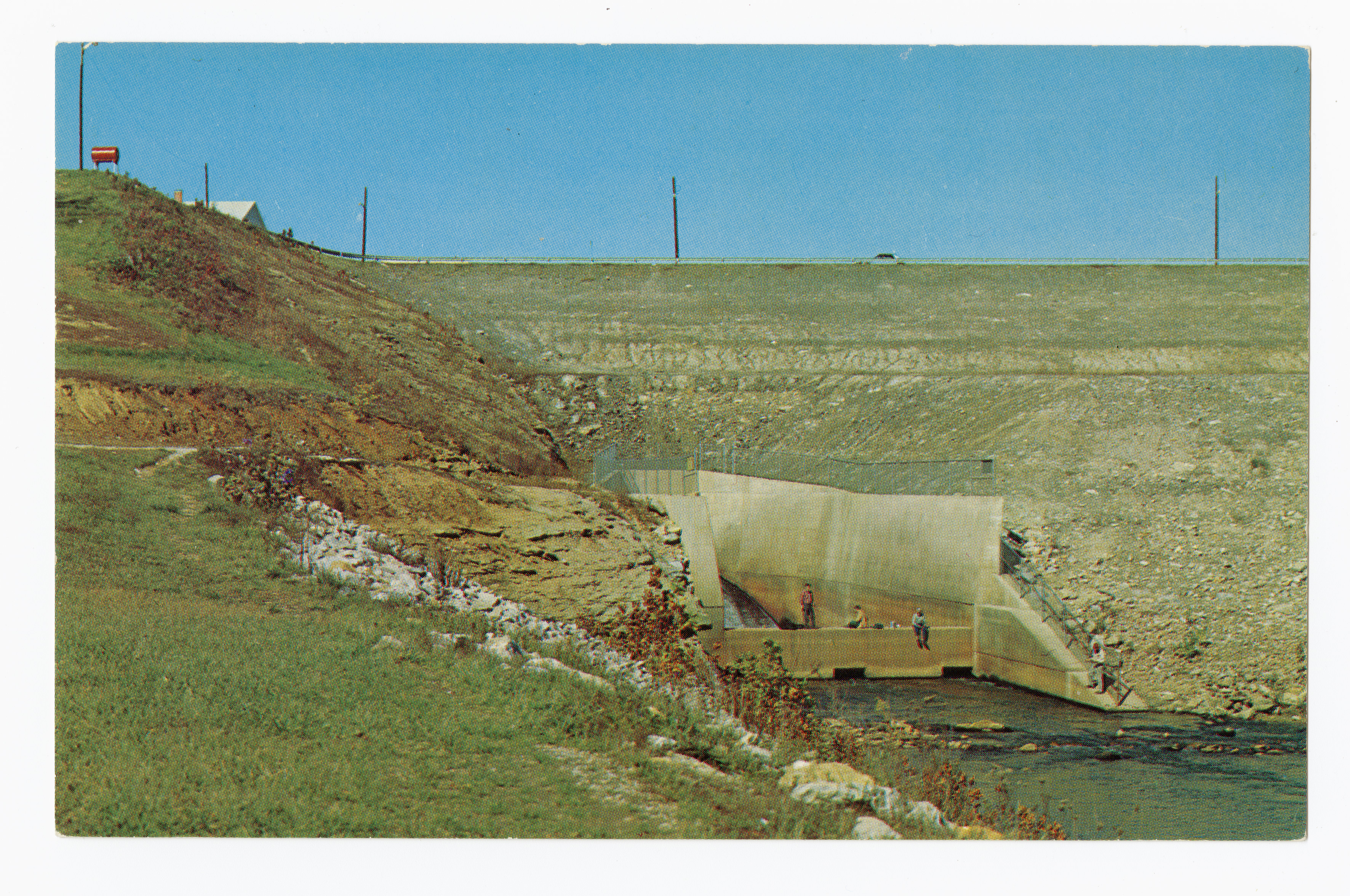 Monroe Reservoir goes into operation with the closing of the gates at the dam. It is Indiana's largest man-made lake, created by the U.S. Corps of Engineers. It covers 10,750 acres with water and 23,952 acres of property along its shore. The U.S. Army Corps of Engineers is to turn over administration to the maintenance and operation division of the Corps, completing the flood control project which began in July 1958. Monroe Reservoir goes into operation with the closing of the gates at the dam. It is Indiana's largest man-made lake, created by the U.S. Corps of Engineers. It covers 10,750 acres with water and 23,952 acres of property along its shore. The U.S. Army Corps of Engineers is to turn over administration to the maintenance and operation division of the Corps, completing the flood control project which began in July 1958.
Source: "Reservoir Gates To Close," Herald Telephone, January 27, 1965, Front, 1. more...
|
| First Black Bloomington Police Officer 1967, Apr 1 |
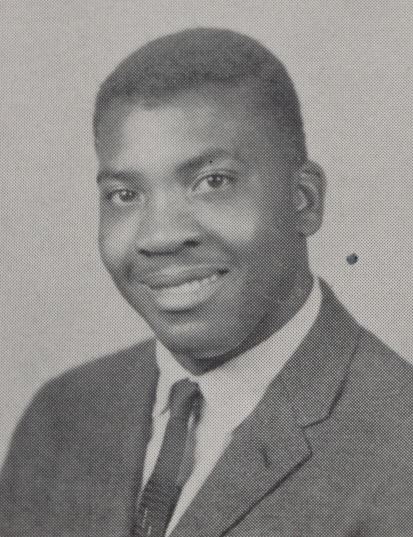 Vietnam War veteran and Bloomington High School graduate Charles Brown becomes first African American police officer in Bloomington history. [Image from 1962 Gothic Yearbook for Bloomington High School.] Vietnam War veteran and Bloomington High School graduate Charles Brown becomes first African American police officer in Bloomington history. [Image from 1962 Gothic Yearbook for Bloomington High School.]
Source: Colin Bishop, "Black History Month Profiles: Brown was city's first black police officer," Herald Times, February 18, 2008, N/A (clipping).
|
| Central Junior High School burns 1967, Apr 6 |
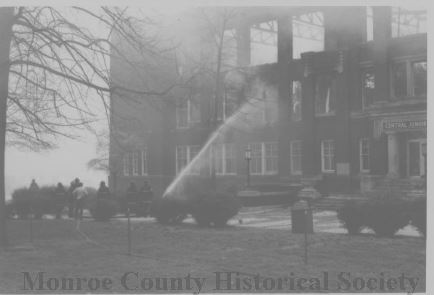 65 firefighters and all available equipment are pressed into service in a general alarm fire that destroys Central Junior High School formerly Bloomington High School. 65 firefighters and all available equipment are pressed into service in a general alarm fire that destroys Central Junior High School formerly Bloomington High School.
Source: "Historic Central High Burns in One of City's Worst Disasters.," Daily Herald Telephone, April 6, 1967.
|
| Monroe County Community Schools organize 1968, May 6 |
Monroe County schools announce that it will be reorganized for the first time in nine years after a vote in the primary election to form the Monroe County Community School Corporation.
Source: "Bloomington's Year: A Look at Major Local News Reported in the H-T in 1968," Herald Telephone, December 31, 1968.
|
| Poor Asylum demolished 1969, Oct |
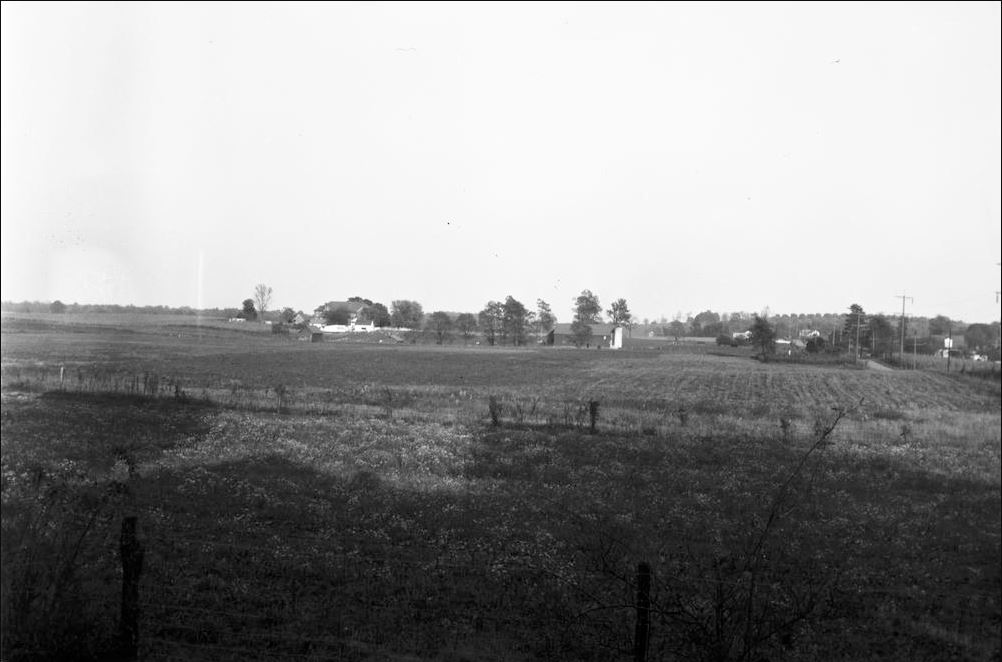 The Monroe County Poor Farm's 30-room building is demolished. The Monroe County Poor Farm's 30-room building is demolished.
Source: Bob Cole, "Poor Farm Site of New County Park," Courier-Tribune, November 26, 1972. more...
|
| Bob Knight hired 1971, Mar |
Bob Knight is hired to coach the IU basketball team in the newly opened Assembly Hall. Knight would go on to coach 29 years for IU until he was fired on September 10, 2000. Knight won 902 games in his career along with 3 national championships at Indiana University.
Source: Bob Hammel and Rich Clarkson, Silver Knight: 25 Remarkable Years of Championship Indiana Basketball (Bloomington: Herald Times, 1997), 4.
|
| Oliver Winery established 1972 |
Oliver Winery, owned by Bill Oliver, is established 7 miles north of Bloomington.
Source: Oliver Winery Pamphlet from July 1980, 1.
|
| Indiana undefeated NCAA Basketball champion 1976, Mar 29 |
Indiana is the last undefeated basketball champion beating Michigan 86-68 for the third time in Philadelphia.
Source: Wikipedia: Indiana Men's Database
|
| "The Herald-Telephone" turns 100 1977, May 12 |
May 12, 1877 marks the date when Walter S. Bradfute and Frank Arnott started the newspaper "The Telephone."
Source: Sunny Schubert, "If they could see us now," Herald Telephone, May 12, 1977, Front Page.
|
| Blizzard of '78 1978, Jan 25 |
The blizzard of 1978 paralyzed Monroe County, closing most businesses and even Indiana University with up to 18 inches of snow and strong winds.
Source: "A walk down a snow-drifted memory lane," Sunday Herald-Times, January 28, 1979, 43.
|
| "Breaking Away" premieres in Bloomington 1979, Jul 20 |
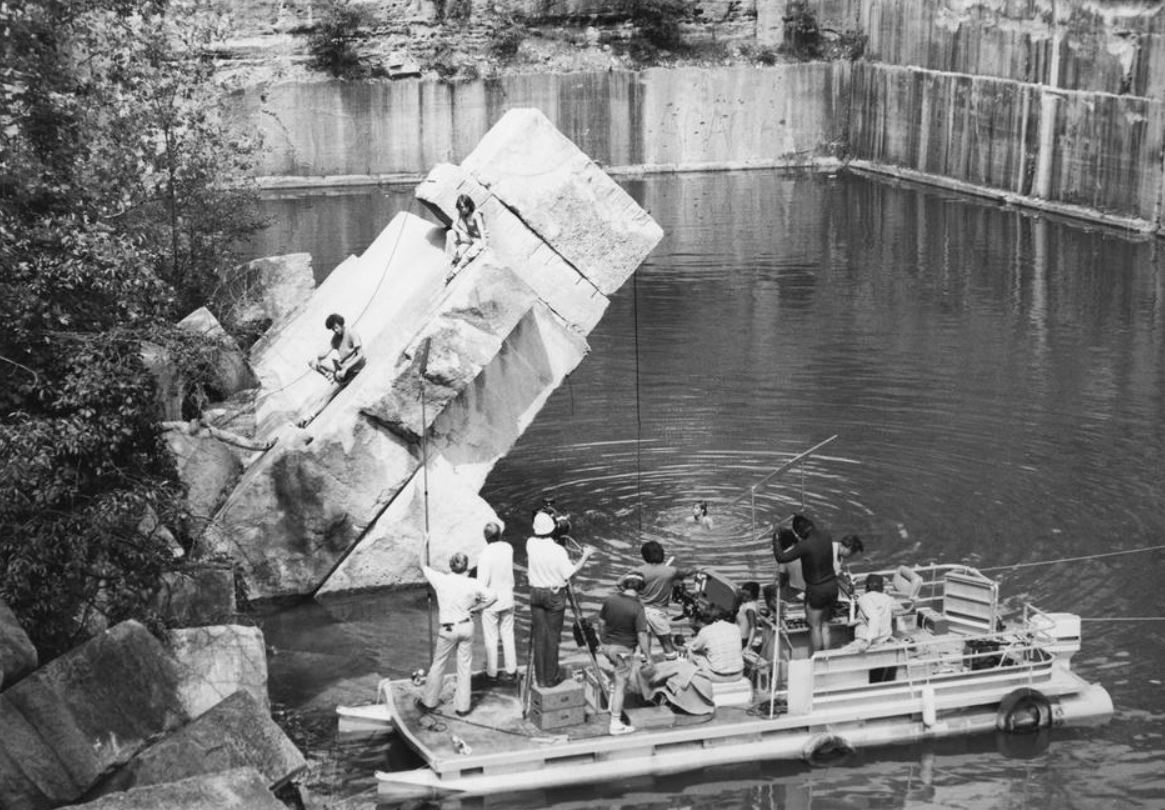 The Towne Cinema, formerly the Harris Grand theater, hosts the premiere of "Breaking Away" filmed in and around Bloomington. The Towne Cinema, formerly the Harris Grand theater, hosts the premiere of "Breaking Away" filmed in and around Bloomington.
Source: Jeff LaFave, "Box office sleeper," Herald Times, April 23, 2014, B, 4. more...
|
| Tomi Allison is elected mayor 1983, Nov |
Tomilea "Tomi" Allison becomes the first female elected mayor of Bloomington and will go on to serve 12 more years. Her legacy is one of revitalization of infrastructure and progress for the city. Allison is not, however, the first woman to serve as mayor. In 1962 Mary Alice Dunlap, who, as deputy, stepped into the role of mayor after Tom Lemon resigned.
Source: Mike Leonard, "Women Who Helped Shape Our Town," Bloom Magazine, February 1, 2015, 102-113.
|
| RCA/Thomson closes factory 1998, Mar 27 |
After 58 years in Bloomington, the RCA plant closes and relocates to Mexico.
Source: Laura Lane, "End of the Line," Herald Times, March 29, 1998, Front, 1, 11.
|
| Elizabeth Bridgwaters named Woman of the Century 1999 |
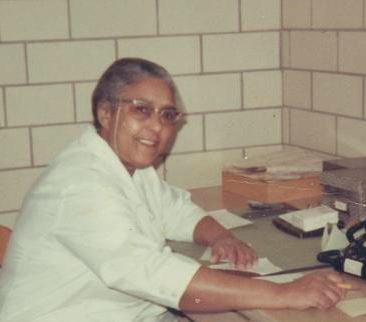 Elizabeth Bridgwaters is named Monroe County Woman of the 20th Century in a poll conducted by the Herald Times newspaper at the end of 1999 due to her numerous contributions to the city of Bloomington. She served through multiple organizations throughout her lifetime, including Monroe County's United Way Chapter, and the National Association for the Advancement of Colored People (NAACP). Elizabeth Bridgwaters is named Monroe County Woman of the 20th Century in a poll conducted by the Herald Times newspaper at the end of 1999 due to her numerous contributions to the city of Bloomington. She served through multiple organizations throughout her lifetime, including Monroe County's United Way Chapter, and the National Association for the Advancement of Colored People (NAACP).
Source: Mike Leonard, "Women Who Helped Shape Our Town," Bloom Magazine, February 15, 2015, 113. more...
|


